TCL MQLED85, or model C765, is a television that can truly surprise, especially in this price range. It is one of the cheapest models featuring mini-LED technology, which is immediately evident in the picture quality. The blacks are deep, and the brightness is sufficient even in a brightly lit room. Thanks to the large number of dimming zones, watching movies in the evening is a pleasure – the blacks are really deep, and the picture in dark scenes looks clear. However, it's not perfect – in some scenes, you may notice minor issues with small bright elements, but this is really a minor detail compared to what this model offers. Google TV performs excellently here – there are plenty of apps, and using the system is simply convenient. Voice control in Polish works flawlessly, which can be particularly useful if you don't want to type movie titles using the remote. Of course, there are minor shortcomings, such as the lack of recording capabilities, but these are not things that interfere with daily use. For gamers, it is also a fantastic option. Support for HDMI 2.1, VRR and low input lag means the television handles consoles well and competes effortlessly with more expensive models from Korean or Japanese manufacturers. At this price, it's hard to find something better when it comes to smooth and responsive gameplay. During testing, we encountered a few minor software issues, but it's hard to say whether that's a serious downside. We hope that TCL will release updates, so there’s a chance this issue will be resolved quickly. TCL MQLED85/C765 is an excellent choice if we are looking for a television with good picture quality and modern features at a reasonable price. It is a model that combines affordable mini-LED technology with a convenient Google TV system, and it’s also great for gaming. Minor software shortcomings are something you can live with, especially considering what this television offers in its class.
- Matching (Score)
- Our verdict
- TV appearance
- Where to buy
- Contrast and black detail
- HDR effect quality
- Factory color reproduction
- Color reproduction after calibration
- Smoothness of tonal transitions
- Image scaling and smoothness of tonal transitions
- Blur and motion smoothness
- Console compatibility and gaming features
- Input lag
- Compatibility with PC
- Viewing angles
- TV efficiency during daytime
- Details about the matrix
- TV features
- Apps
- Playing files from USB
- Sound
TCL MQLED85 / C765 vs SAMSUNG QN80F
Direct compare
C765 / MQLED85
QN80F

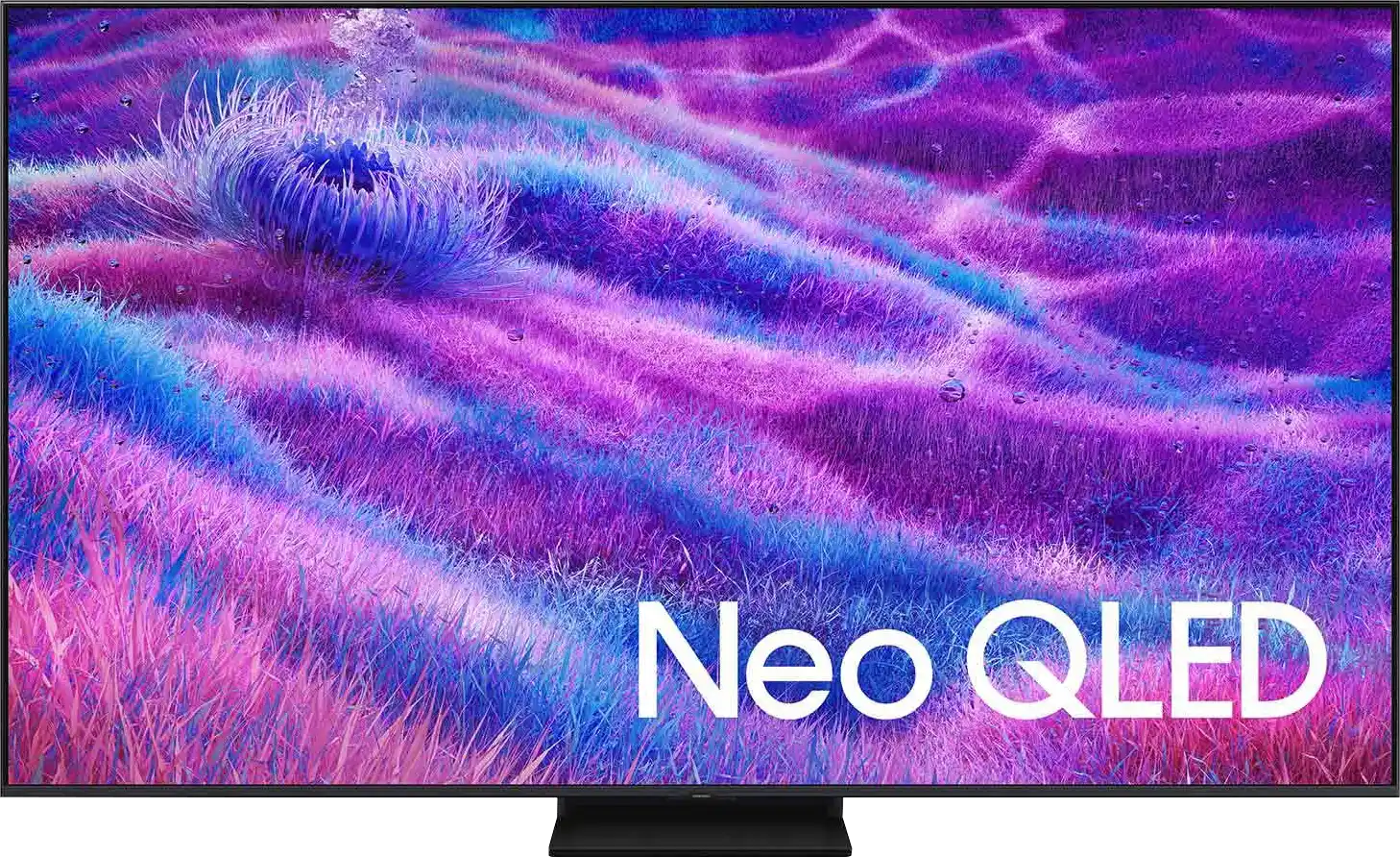
Panel type: LCD VA
Resolution: 3840x2160
System: Google TV
Model year: 2024
Complete the survey to find out the result

Panel type: LCD VA
Resolution: 3840x2160
System: Tizen
Model year: 2025
Complete the survey to find out the result

Overall rating
7.2
7.3
Movies and series in UHD quality
6.8
6.9
Classic TV, YouTube
6.6
6.8
Sports broadcasts (TV and apps)
6.5
6.7
Gaming on console
8.6
8.5
TV as a computer monitor
8.6
8.8
Watching in bright light
6.3
6.6
Utility functions
7.1
7.5
Apps
9.6
8.7
Sound quality
6.9
6.7
Complete the survey to find out what fits your preferences
Advantages
Great choice for gamers - lots of features, low input lag, 144Hz
High panel brightness - good performance during the day
Good black levels and contrast
Comprehensive Google TV
Premium build at a low price
Great black levels and contrast - VA panel combined with MINI-LED backlighting.
Excellent brightness - up to 1000 nits in HDR
Fast and responsive panel - 144 Hz
Robust support for gamers - 4xHDMI 2.1, VRR, ALLM, GameBar, Game Motion Plus
Very good usability in daylight
Advanced Tizen operating system
Easy to use
PiP function
Disadvantages
Average viewing angles
No recording function
No DTS format support – a limitation when connecting a home theatre system
No USB recording function
Relatively few dimming zones
Issues with the HGiG function (for gamers) – the update removed this option*
Our verdict
QN80F is the first in the history of Samsung's "eighty range" to feature Mini LED backlighting. And it does it really well. Although the number of dimming zones isn't staggering, the black levels are solid, and in combination with high brightness, it allows for a very decent picture in HDR content. Additionally, there's a 144 Hz panel that provides excellent motion fluidity, and the gaming features – VRR, ALLM, Game Motion Plus – make the QN80F an option truly designed for those gaming on consoles or PCs. The television operates quickly and responsively, and the Tizen system runs like lightning – whether you’re searching for apps or switching sources. Is there anything to nitpick? Of course, as always – there are shortcomings in the system (like USB recording), DTS support is absent, and Mini LED comes with its own limitations. But the QN80F is a fantastic everyday television – versatile, refined, and... with great price potential. Looking at the history of this series, we can expect that this "eighty" will still shake things up once it hits the first reasonable promotions. And then it could be virtually unbeatable at its price – especially if Samsung fixes the minor teething issues.
TV appearance





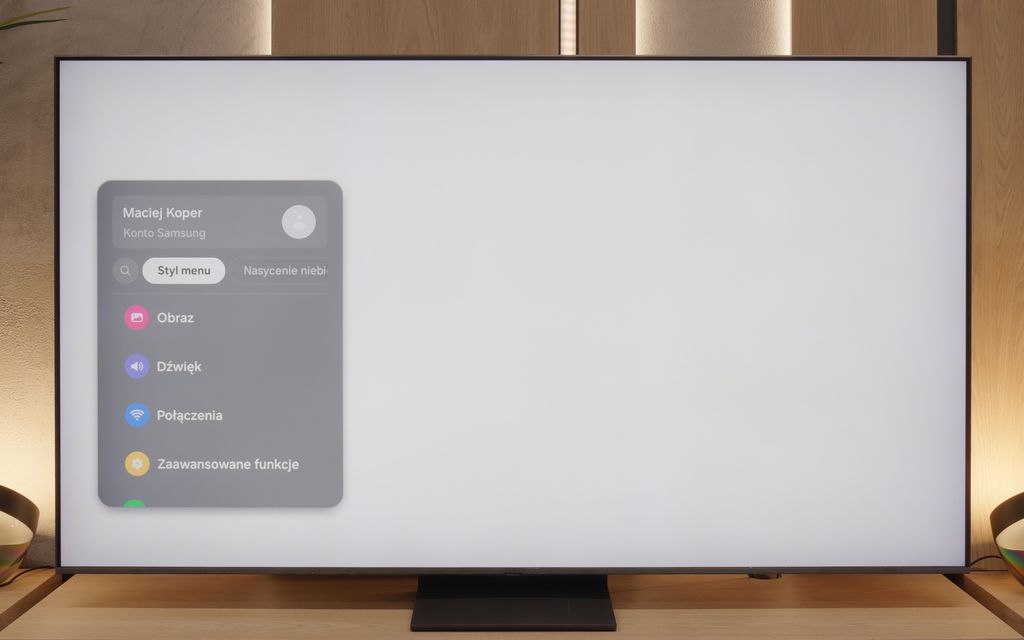
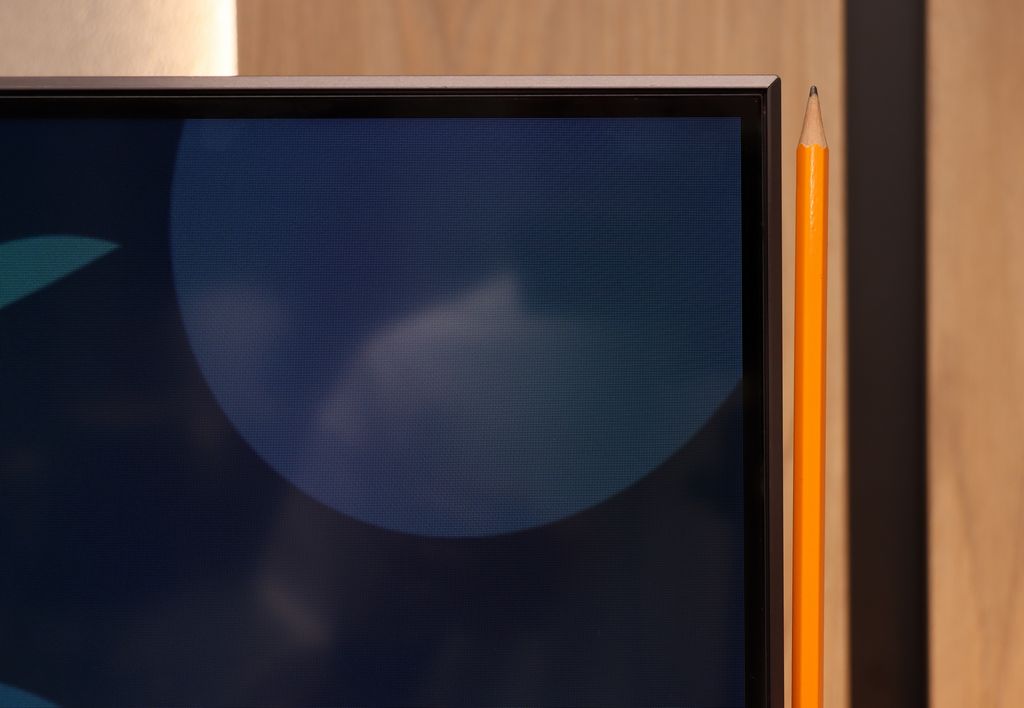
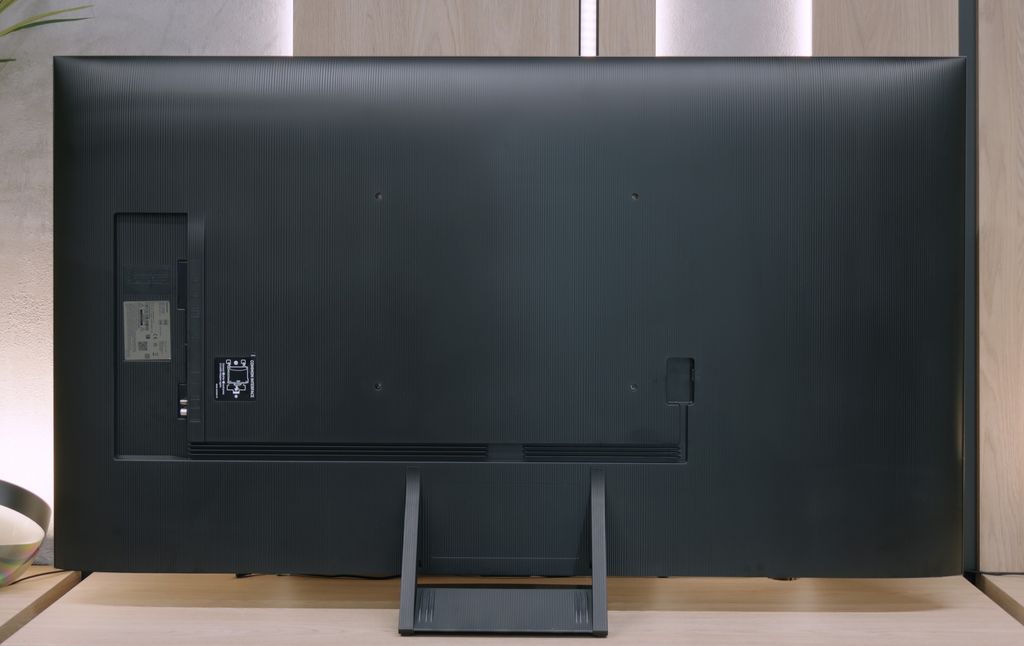

Contrast and black detail
7.7/10
6.8/10
Local dimming function: Yes, number of zones: 720 (36 x 20)
Local dimming function: Yes, number of zones: 88 (8 x 11)
Contrast:

Result
∞:1

Result
30,150:1

Result
17,500:1

Result
9,500:1

Result
5,750:1

Result
34,100:1

Result
8,200:1

Result
32,500:1

Result
4,550:1

Result
3,800:1
Halo effect and black detail visibility:

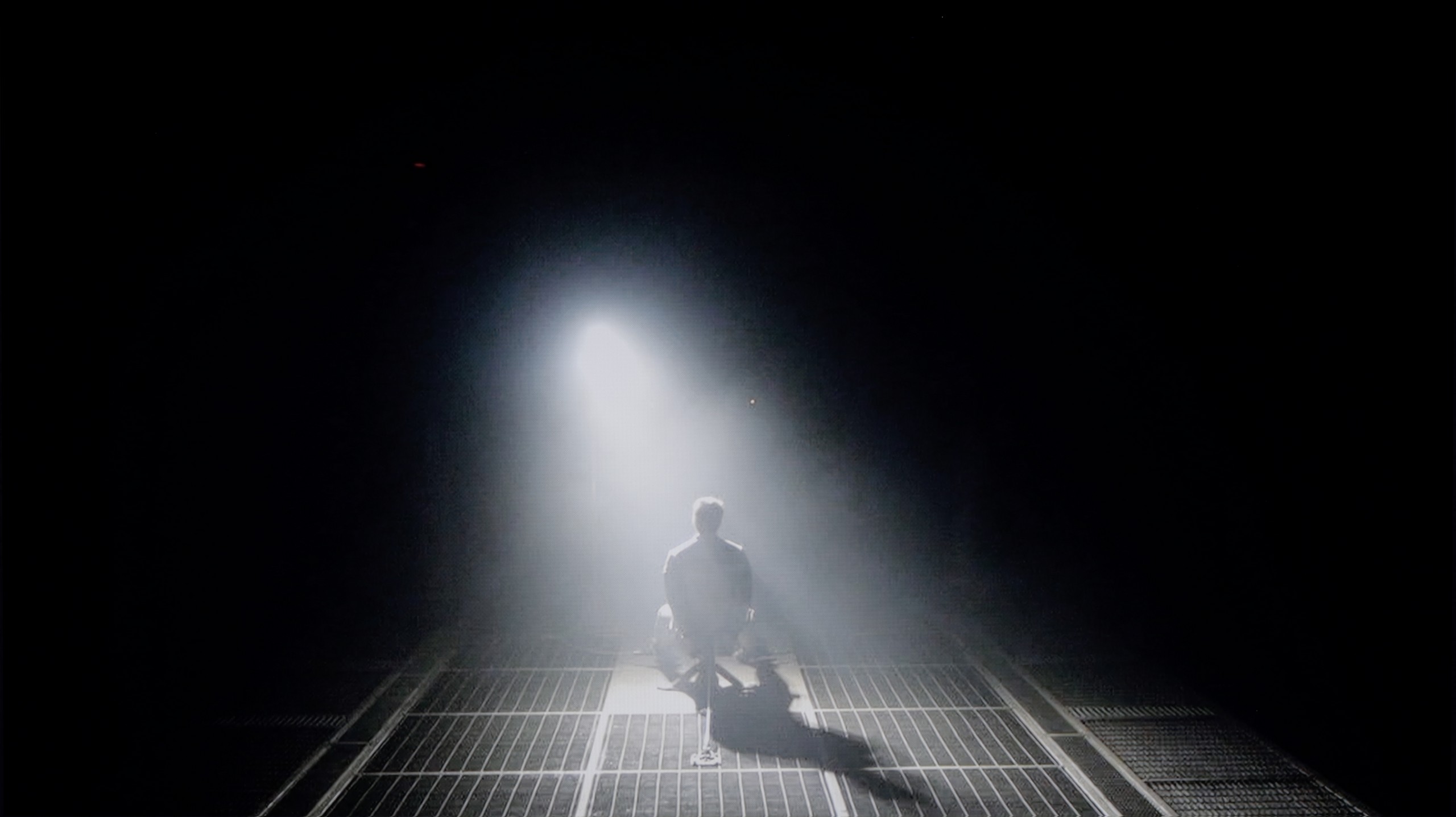
TCL MQLED85/C765 stands out due to its use of a VA panel and Mini LED backlighting, which makes a huge difference compared to traditional backlighting systems. Mini LED, with its significantly smaller diodes, allows for more precise control of the screen's backlighting, resulting in much better contrast and deeper blacks. The model with a 55-inch diagonal that we are testing has an impressive number of over 700 local dimming zones, providing exceptional precision in image display. It's worth noting, however, that the number of backlighting zones may vary depending on the screen size – for larger diagonals, the number of zones naturally increases due to the larger screen area, allowing larger sizes to achieve better results in terms of contrast and black levels. Thanks to the enormous number of zones, the TCL MQLED85/C765 achieved results comparable to OLED screens on our first test pattern from the movie "Oblivion," offering nearly reference-level contrast. But what happens when we test this model in even more demanding conditions? How will the TV perform in tougher scenarios? Overall, the TCL MQLED85/C765 performs very well with black levels, but in some cases, the local dimming algorithm is not perfect. On dark backgrounds, smaller bright elements can lose clarity and brightness, as confirmed by our latest pattern from the Pioneer Kuro test disc. Despite some imperfections in the local dimming algorithm, and thus a slight occurrence of the HALO effect (which is a bright halo around bright objects on a dark background caused by deficiencies in the screen's local dimming), the results achieved by the TCL MQLED85/C765 are impressive, especially considering its price. This TV offers contrast and black depth that can compete with models that are even twice as expensive.
QN80F is a representative of the Neo QLED series, meaning it is a television with Mini LED backlighting. Unlike its cheaper cousin, the QN70F model, the diodes here are placed directly behind the panel (instead of at the edges), which gives a solid advantage from the start when it comes to contrast control. In the 65-inch variant we tested, we counted 88 dimming zones – a result that may not be very impressive, but as it turned out, sufficient to achieve quite decent results.
In tests based on scenes from films such as Oblivion or The Meg, the QN80F performed well – blacks were deep, and the overall image consistency was eye-catching. However, in more demanding moments (e.g., scenes with a large number of bright details on a dark background), a halo effect appeared. This is where the limitation of the number of zones comes into play – bright elements could bleed around, and some details in dark areas became less visible. In one scene with a helicopter (The Meg), we even noticed slight brightness flickering, as if the television was trying its best to maintain visibility of the details at the expense of black depth.
However, these are not issues exclusive to this model – the halo effect or contrast drops in very complex scenes are something that most Mini LED televisions struggle with, even the more expensive ones. In its class, the QN80F still performs positively and offers noticeably better contrast than the QN70F model with edge lighting. For most users, this will be a level more than sufficient – although not perfect.
HDR effect quality
6/10
5.8/10
Luminance measurements in HDR:

Result
1016 nit

Result
365 nit

Result
765 nit

Result
235 nit

Result
1178 nit

Result
799 nit

Result
533 nit

Result
717 nit

Result
245 nit

Result
656 nit
Scene from the movie “Pan” (about 2800 nits)

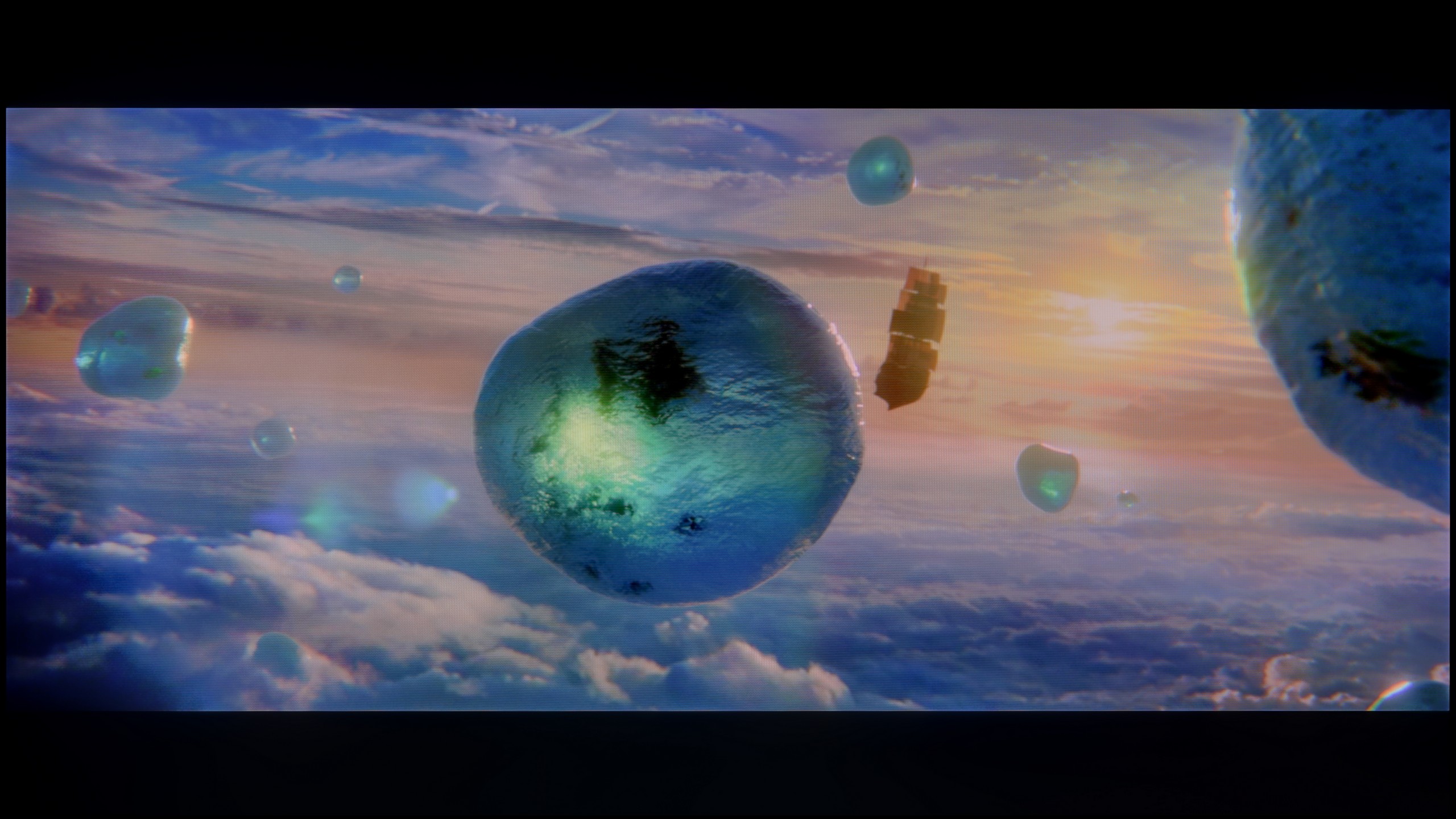
Scene from the movie “Billy Lynn” (about 1100 nits)

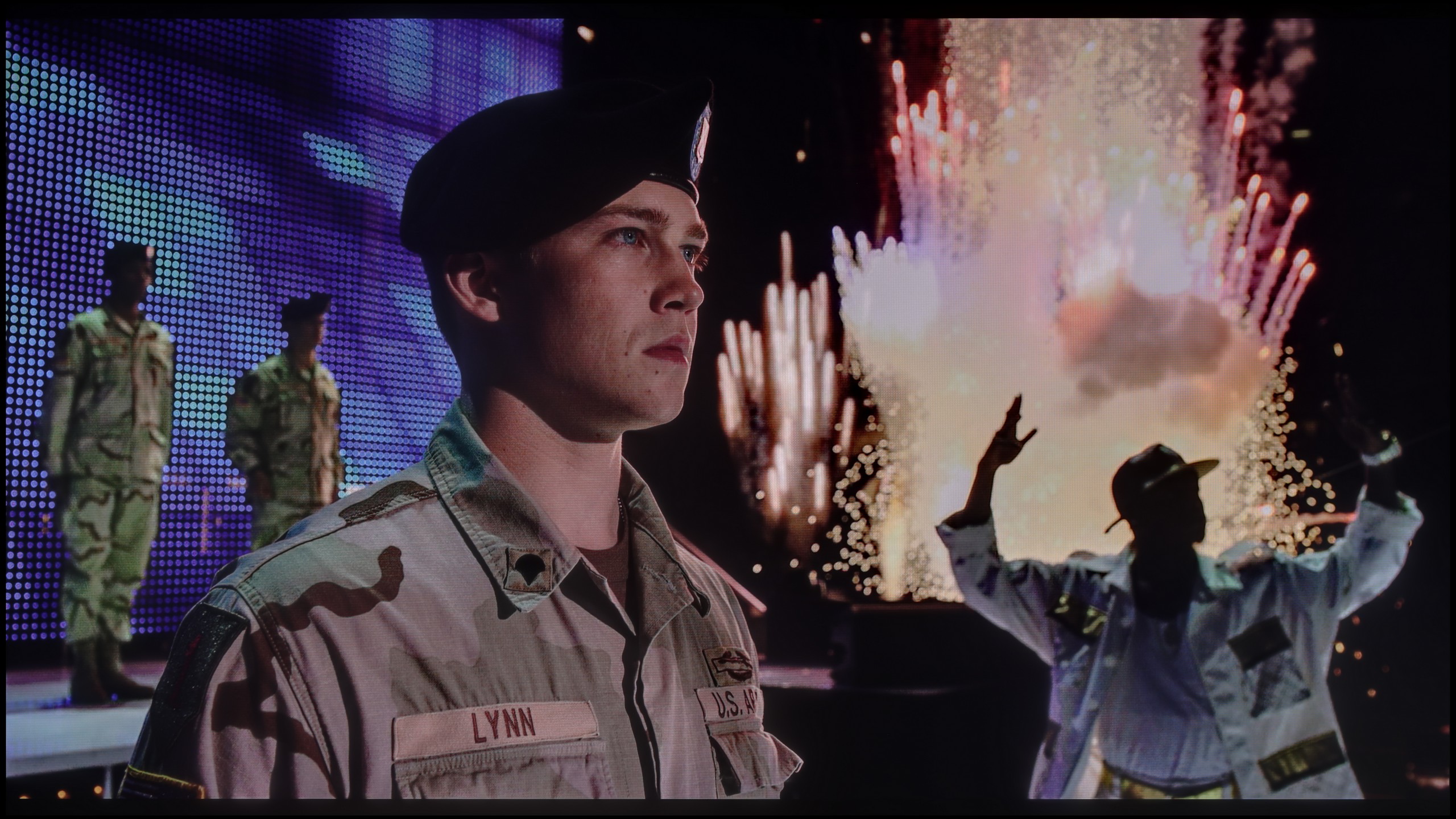
Static HDR10


Dynamic: Dolby Vision
Dynamic: HDR10+


HDR luminance chart:
SAMSUNG QN80F
Luminancja HDR
Luminance of RGB colors
TCL MQLED85 / C765
Luminancja HDR
Luminance of RGB colors
The television TCL MQLED85/C765 performs well in handling HDR. In the tested movie scenes, where the screen is at 100% brightness, the model achieves impressive results around 1000 nits, providing intense and realistic rendering of HDR content. However, similar to contrast, the dimming algorithm may show some limitations. Despite a large number of Mini LED zones, the television does not always manage to "wow" the user with brightness in very challenging test scenes. For instance, in the scene from the film "Life of Pi," where a bright moon appears against a dark background, and in another scene from "Sicario 2," where a very bright light effect is visible against a dark background, the television did not reach maximum intensity. For users expecting a perfect HDR effect in such extreme cases, the TCL MQLED may come up a bit short. However, in terms of colours, the television stands out with a very high coverage of the DCI P3 colour gamut at 95%, which is an impressive result comparable to much more expensive models. TCL MQLED85 / C765 offers support for various HDR formats, including Dolby Vision and HDR10+, which is crucial for cinema image fans. Although this model achieves brightness over 1000 nits, the TCL MQLED85 may struggle to reflect details in very high-contrast scenes. For better HDR quality control, the C765 is equipped with dynamic tone mapping, making the image more realistic and natural depending on the content.
QN80F is quite a bright screen – in synthetic tests, it reached nearly 1000 nits, which allows for reasonable expectations of HDR content. And indeed, in many scenes, the TV can truly shine. Sequences with a lot of light – like shots from the movie Life of Pi or wide, bright surfaces in The Meg – look impressive. Brightness stays around 700 nits, which provides a solid effect, enough to feel the true "HDR magic." Unfortunately, not every scene looks this good. In content with small, bright details on a dark background, like in Sicario 2, the TV can struggle – it can significantly dim individual elements, sometimes to the point where they disappear from the image. This is a result of the limited number of dimming zones, forcing the device into compromises: either stick to inky blacks or sacrifice some detail. QN80F usually chooses the former. As a consolation, it offers quite decent coverage of a wide color palette – DCI-P3 at 93%. It's not the highest score on the market, but it's more than enough for most content on streaming platforms.
Factory color reproduction
5.2/10
6/10


Factory Mode
After calibration


Factory Mode
After calibration
The television TCL MQLED85/C765 was tested in movie mode, which, while seeming to be the best setting from the manufacturer, is not without its flaws. The colour reproduction in HD/SDR mode MQLED85 shows certain shortcomings. In the analysis of white balance, there is a significant lack of blue colour, which can affect the overall image quality, particularly in bright scenes where blue shades are crucial for natural representation. The overall image may then appear too warm. As for gamma contrast, the graph shows that there is a large jump above the reference line of level 2.4 at the beginning, which may suggest significant dimming of brightness in darker areas, leading to loss of detail in blacks. Then for most of the time, the values are below this line, which can lead to loss of detail in the brighter parts of the image. Such a distribution may negatively impact the perceived image quality, especially when watching regular TV in HD quality.
In the case of the 4K HDR image quality of the TCL MQLED85/C765 television, there is a noticeable excess of red colour in the analysis of white balance. This excess can significantly impact the viewer's experience, leading to several notable effects. First and foremost, an excessive amount of red can make other colours, such as green or blue, appear muted or unnatural. This distortion of colour balance can result in an overall impression of "oversaturation," which detracts from the image's naturalness and authenticity. In terms of contrast, the EOTF (Electro-Optical Transfer Function) graph indicates that most values are above the reference line, suggesting an intense boost in brightness in the bright areas of the image. However, the exception is the start of the graph, where the EOTF line is below the reference, which may lead to excessive dimming of small light elements.
Users should be aware that despite using the best mode, which is movie mode, the television is not free from flaws in the context of image settings, so it is worth considering adjusting the settings to achieve better results.
We always test TVs in the best available factory mode – for the Samsung QN80F, this is the Filmmaker mode, and indeed, it provides the settings closest to the creators' intentions. However, this doesn’t mean everything looks perfect. In SDR content, the biggest issue was an unbalanced white balance – slight deficiencies in green and a noticeable excess of red led to noticeable colour errors, and one could say the screen had a pinkish hue. This was clearly visible in the colour checker test, where colours “escaped” outside their target fields – to such an extent that a sensitive viewer's eye could catch it even without the help of a meter.
In HDR content, the white balance was much better, but another issue arose – brightness management. The EOTF curve caused an overly bright image most of the time, which affected the perception of contrast and made the screen slightly “flicker” during dynamic changes in light. We’ve already discussed this in the paragraphs about black levels and HDR. Fortunately, Samsung offers users plenty of options. The QN80F features a rich set of calibration options, including a 20-point white balance – which is why we decided to check what this TV is really capable of after a proper calibration.
Color reproduction after calibration
7.8/10
8.3/10

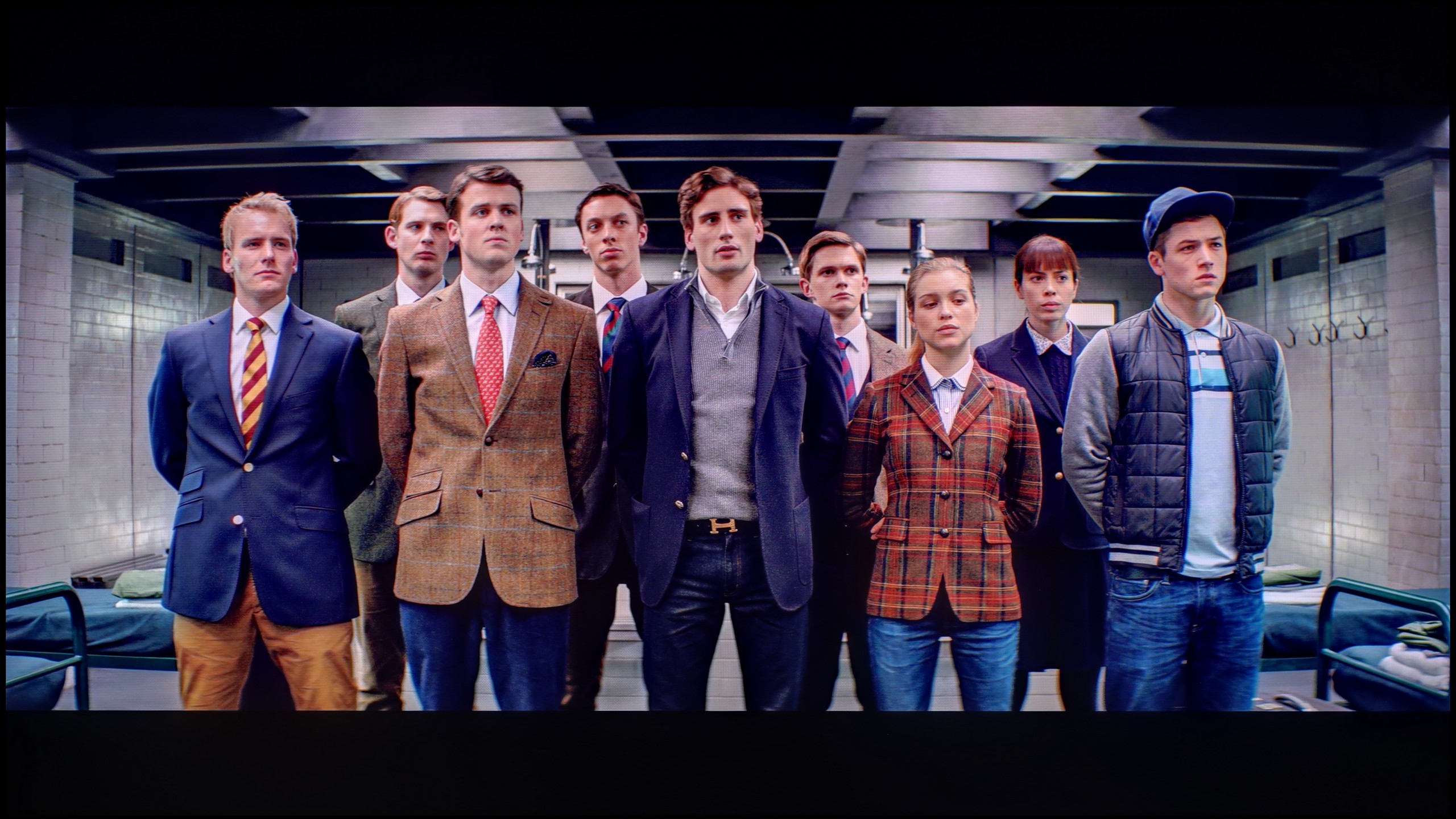

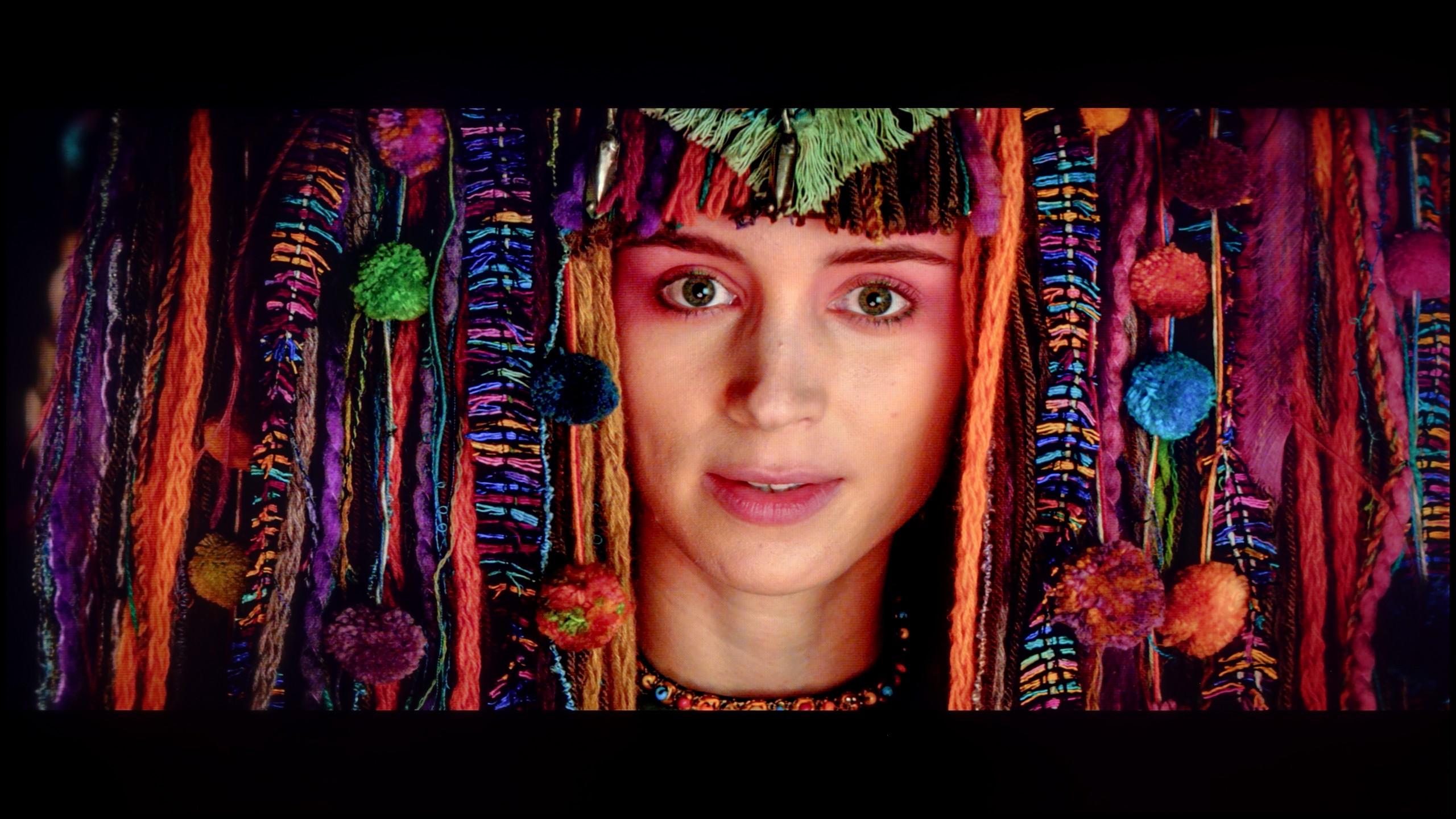
After professional calibration of the television TCL MQLED85/C765, its colour properties in film mode have significantly improved, resulting in much more satisfying visual experiences. Both in SDR and HDR modes, the white balance shows no serious errors, and the graph appears to be much better harmonised. Users can now enjoy natural colour reproduction, which is crucial for achieving an authentic experience while watching films. It is worth noting that in HDR content, there may be minor colour reproduction errors at the end of the graph, but these are significantly smaller than before calibration. As a result, characters and landscapes become more realistic, enhancing the depth of immersion in the story.
Regarding contrast, the gamma curve, responsible for HD quality, has been completely free of drops below the reference line, which means better visibility of details in dark scenes. However, there is still a slight boost at the beginning of the graph, which may affect the perception of bright elements. For HDR content, the EOTF curve also shows fewer errors, although some issues with reproducing mid-tones may still be noticeable. The EOTF curve measured on real film scenes still shows a significant brightness boost, so the image may appear more intense but artificially brightened. This is a typical problem for TCL brand televisions, which may appeal to untrained viewers but can frustrate those more familiar with an ideal image.
What benefits does professional calibration bring to film enthusiasts? Thanks to it, viewing becomes even more realistic and immersive, allowing every scene to be experienced fully, preserving details and natural colours.
After conducting a thorough calibration, it was possible to bring most image parameters to a really good level. The white balance in both SDR and HDR presents itself almost perfectly – the image is natural, neutral, and free from the previously noticeable redness. Colours have gained depth, and the overall visual experience has become more pleasant and cohesive. It was also possible to partially manage brightness, which in the factory version could cause issues. The EOTF chart shows that the television performs much better with brightness after calibration – there is no longer excessive dimming of certain elements. In films, it can still be noticed that the QN80F has a tendency to slightly brighten the smallest bright details – this is already a consequence of the device's construction and the limited number of dimming zones. In short: not everything can be overcome, but what was possible has been improved. After calibration, the QN80F makes a really good impression, looking simply more mature and professional.
Smoothness of tonal transitions
7/10
9/10

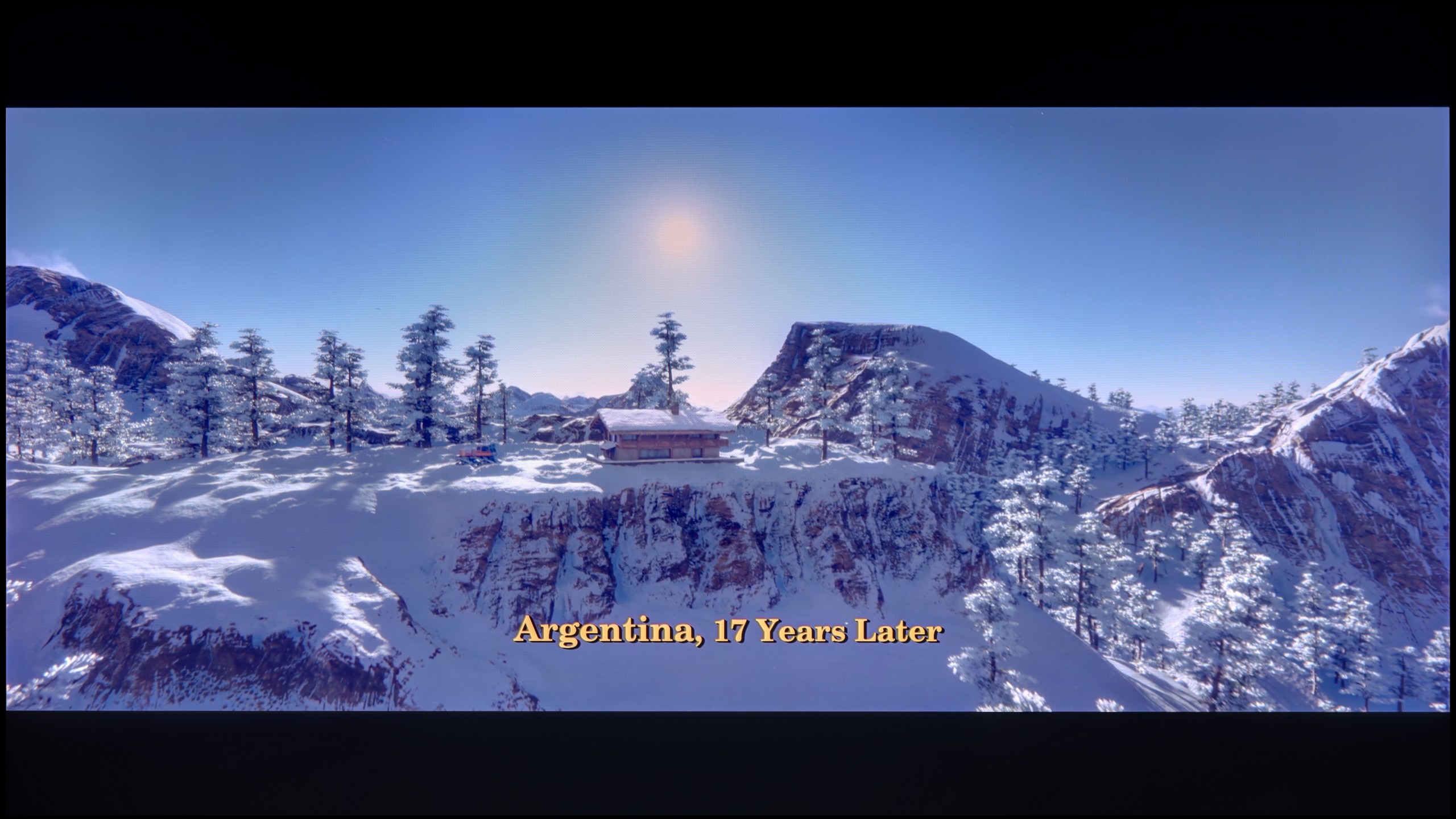



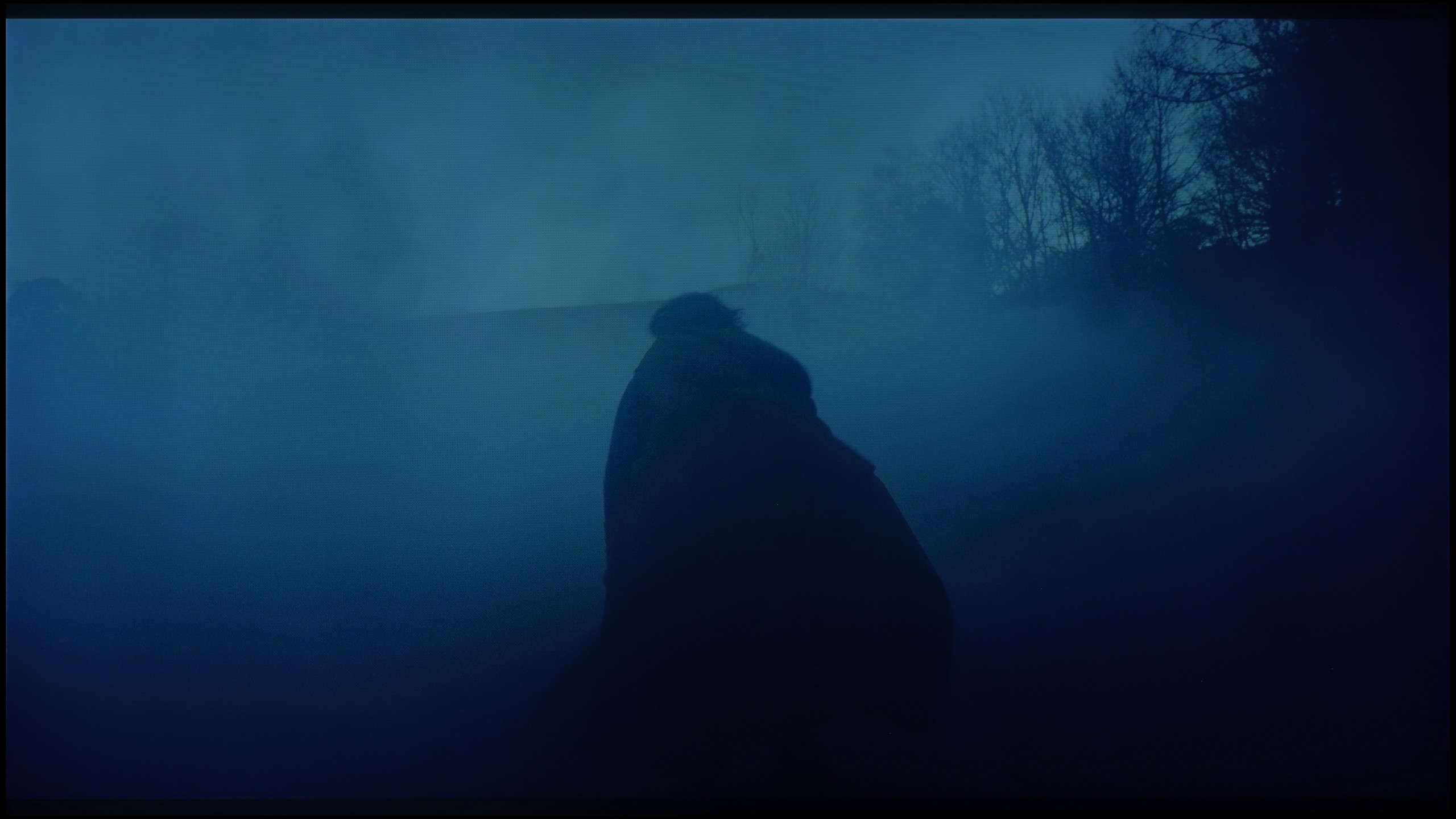

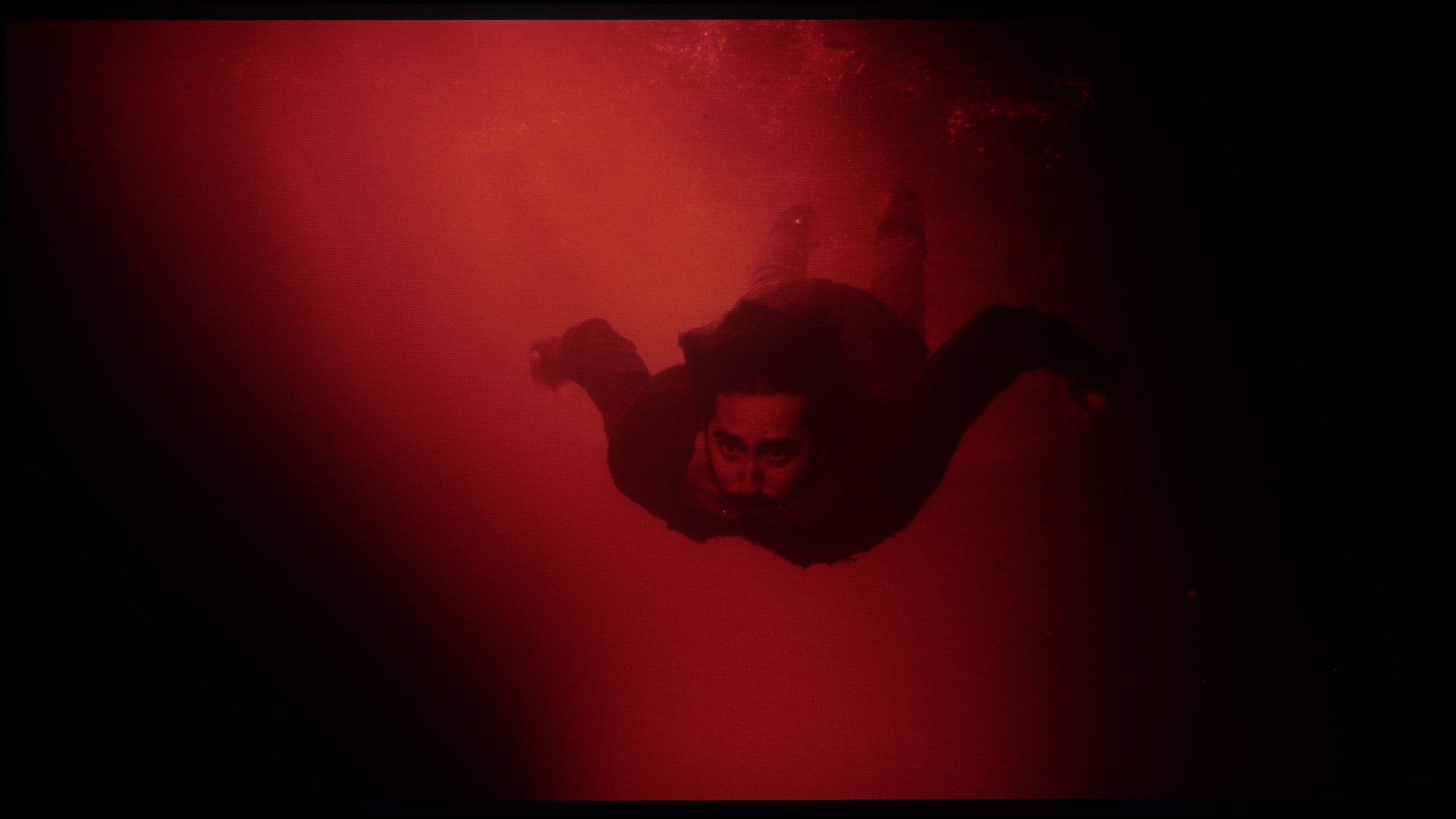




The fluidity of tonal transitions in the TCL MQLED85/C765 television is decent, although noticeable issues arise in both bright and dark test scenes. Particularly evident are the colour joins in the scene from the film "The Green Knight", where the red colour of the water transitions to black. Despite these imperfections, the overall gradient quality is acceptable and does not overly detract from the visual experience. The television handles most scenes well, offering satisfactory tonal transitions, contributing to an overall satisfying visual experience that won't spoil our cinematic enjoyment.
In this regard, the QN80F really delivers. Transitions between colours are smooth, nothing tears, and there are no annoying bands in the sky or strange spots in the shadows. Movie scenes in darker tones performed particularly well – and that's where most televisions start to struggle. If you really focus, you might notice slight banding in the brightest areas, but that's really stretching it. In everyday viewing, no one should have a problem with this. To put it simply: the tonal transitions are so good that you can forget about them – and just enjoy the movie.
Image scaling and smoothness of tonal transitions
5.1/10
7/10
Smooth transition function


Image without overscan on the SD signal

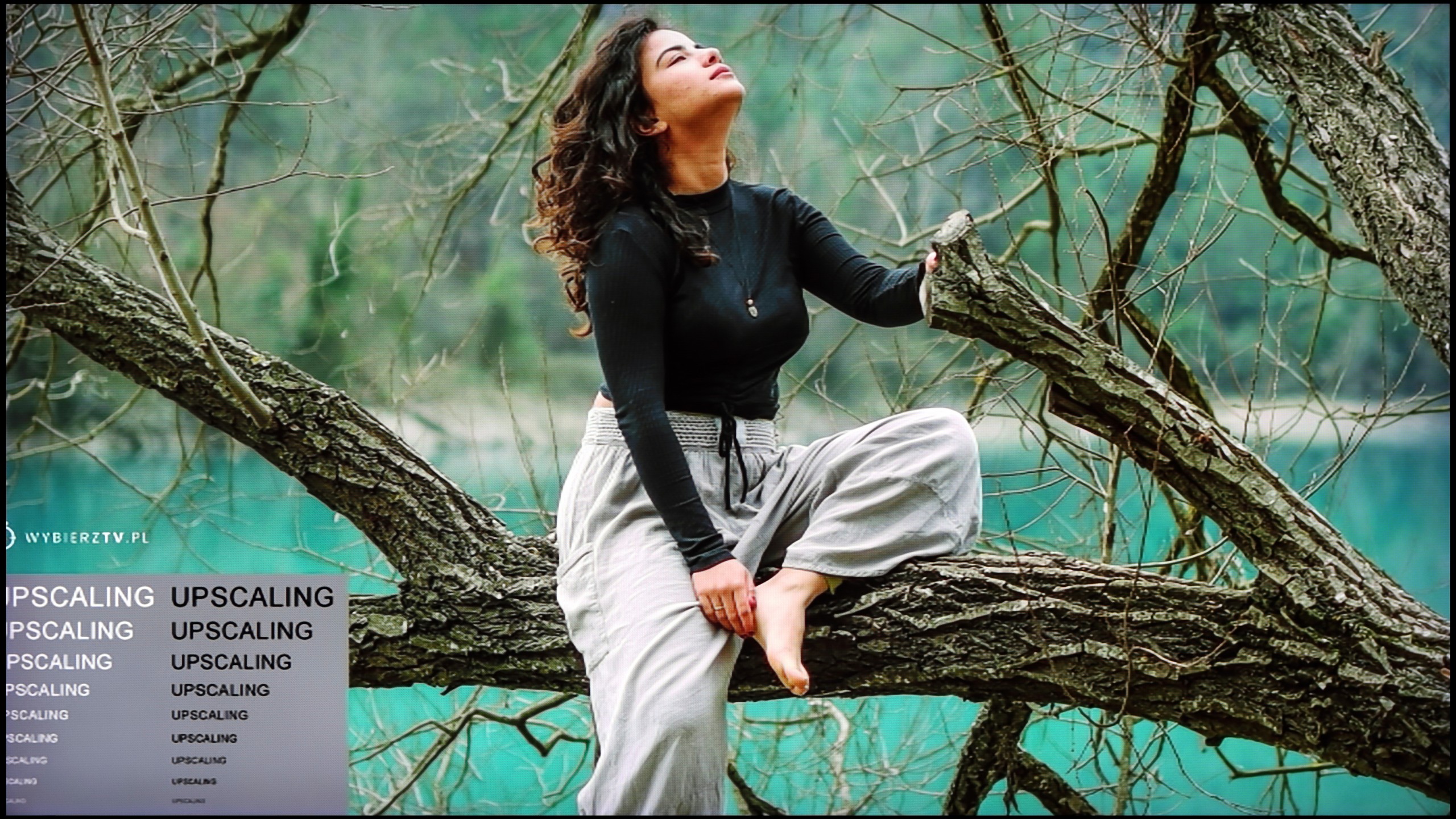
We will now take another look at the tonal transitions on the TCL MQLED85/C765 TV, but in the context of lower image quality. Despite the presence of the "Gradual Smoothing" option, when set to "low", the effects are practically invisible, disappointing users who expect an improvement in image quality. On the other hand, the "high" setting yields minimal results, and worse still, it can blur important details, negatively impacting the sharpness and clarity of the displayed image. However, in the context of image scaling, the TV successfully displayed the image without overscan, meaning we do not lose any part of the view. The image looks quite decent, and details such as tree branches or the outlines of models do not show significant jaggedness, which positively affects the visual quality.
If you notice strange colour transitions or unwanted artefacts while watching lower quality materials – for example from YouTube – it's worth checking the settings and enabling the noise reduction feature. In our opinion, the best setting is at the 'medium' level – it effectively smooths out problematic colour transitions without overly blurring the entire image. However, it's important to know one thing: this option tends to remove film grain. If someone values preserving that effect (e.g., in older films), it's better to simply turn it off – regardless of the level, the grain always disappears.
Regarding resolution scaling (also known as upscaling), Samsung – as usual – performs very well in this area. The QN80F doesn't quite match the top models costing tens of thousands, but for its price class, it performs impressively. Materials of very poor quality (e.g., from SD television or older video files) are noticeably improved and look surprisingly decent. The only noticeable downside is the typical Samsung issue with overscan – which is a slight cropping of the image edges at very low resolutions, such as 576p.
Blur and motion smoothness
7.5/10
7.5/10

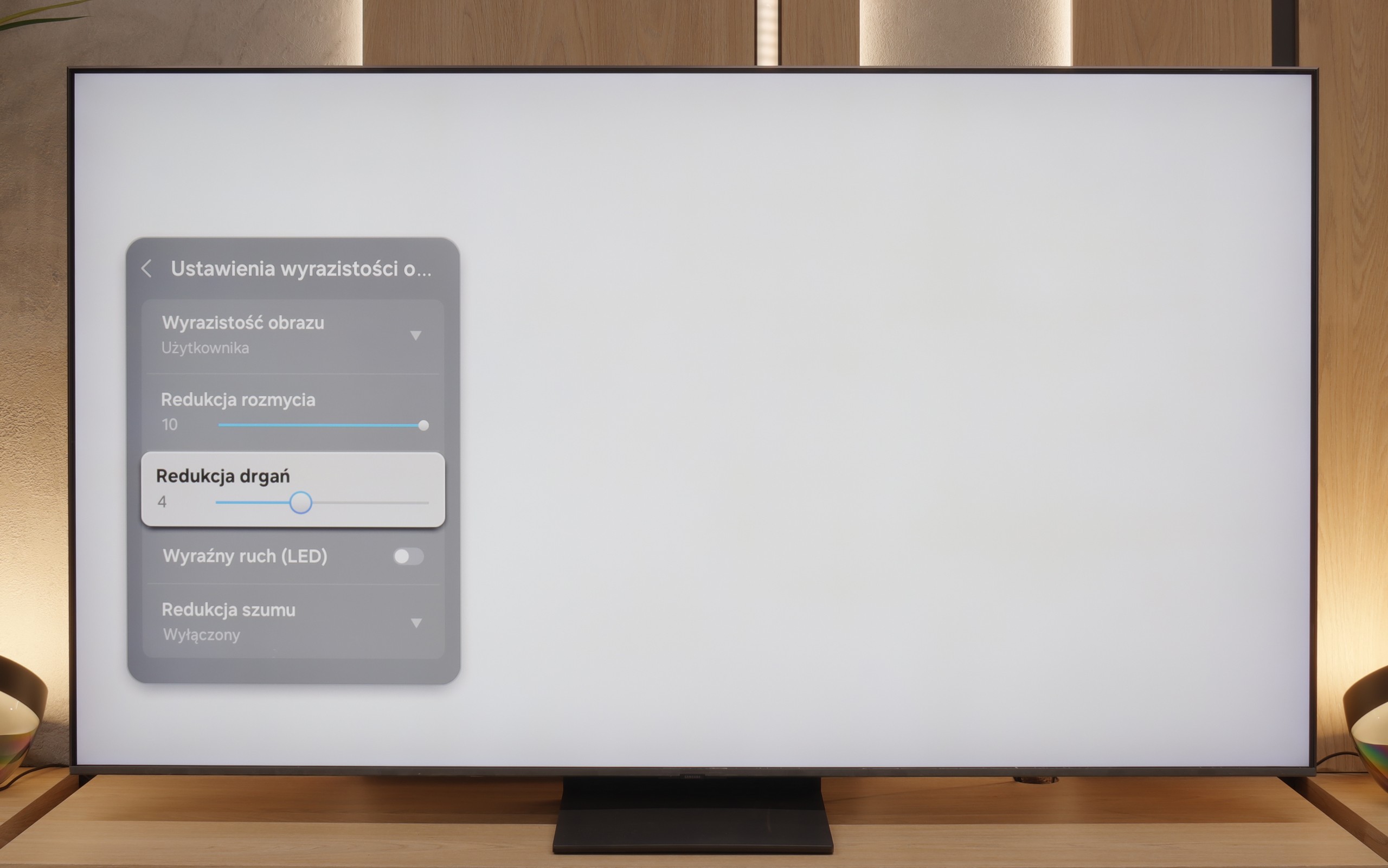
Blur (native resolution, maximum refresh rate):



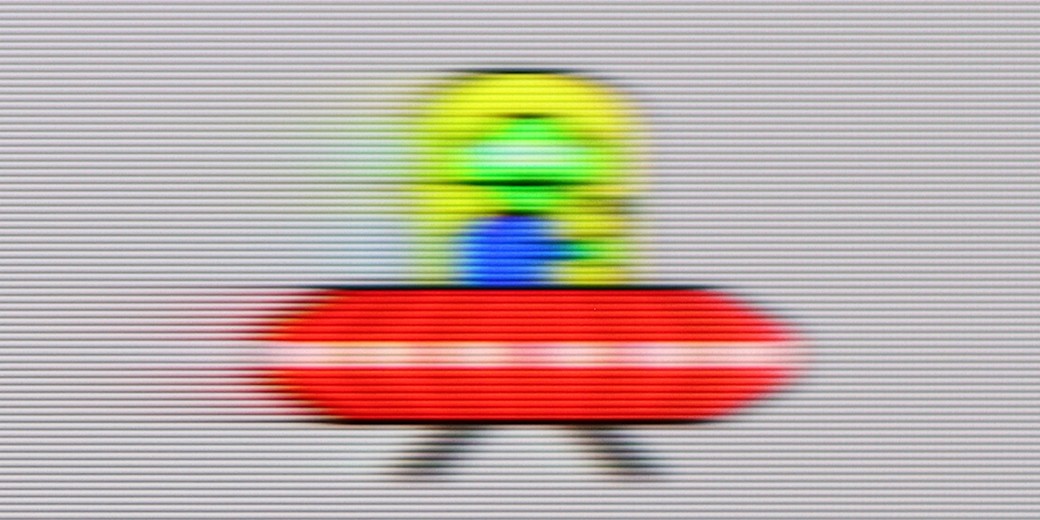
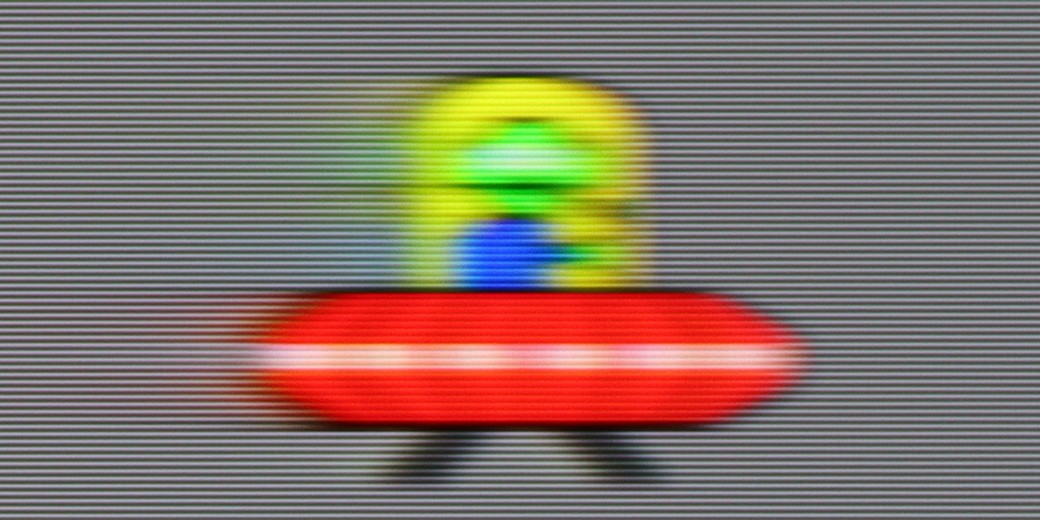
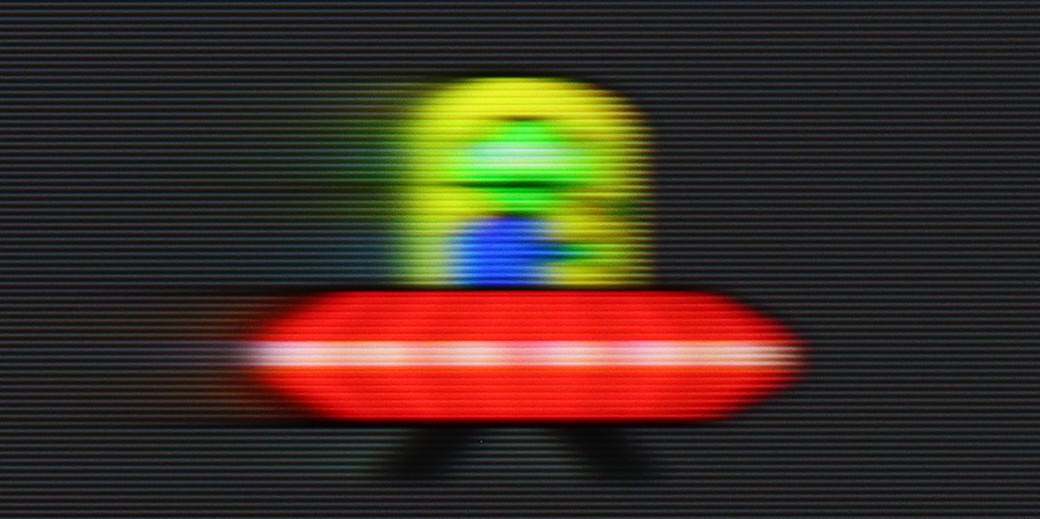
Blur (BFI function enabled):



Image flickers in this mode

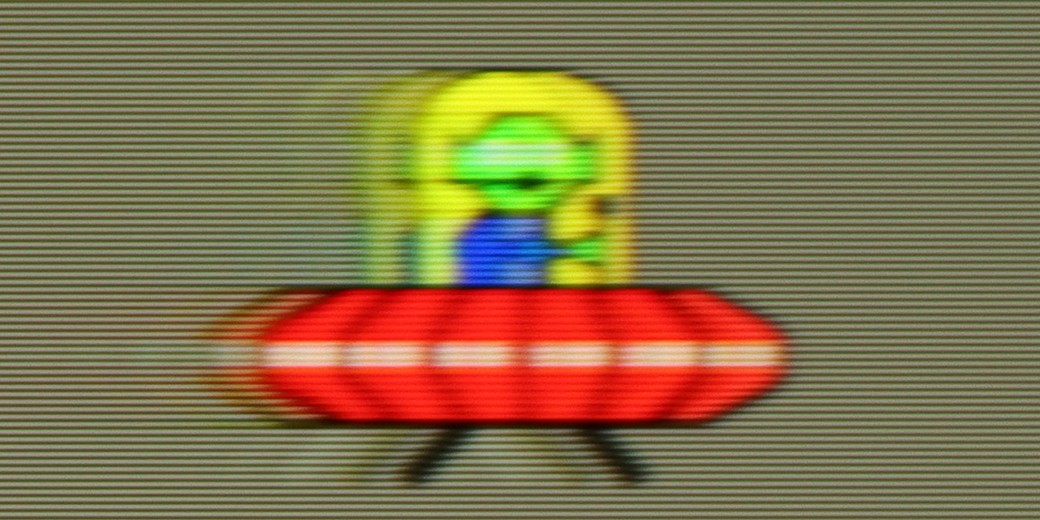
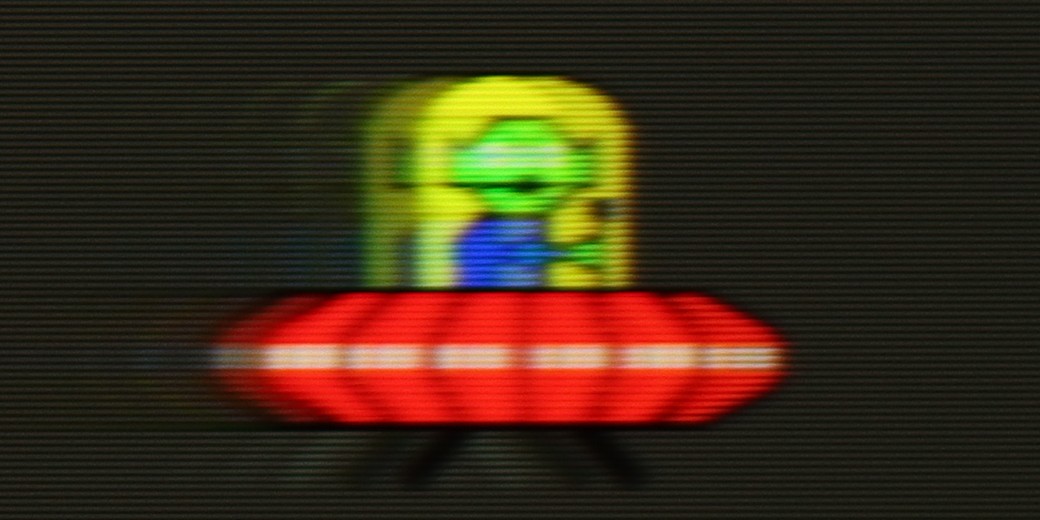
TCL MQLED85/C765 is equipped with a standard refresh rate panel of 120 Hz, with the possibility of increasing it to 144 Hz when connected to a powerful computer. The television also offers a multi-level motion smoother, which is mainly aimed at users wanting to improve the fluidity of motion in films. It allows for adjusting the intensity of the effect on a scale from 0 to 10, enabling precise tailoring of the image smoothness to individual preferences. The response time of the panel is decent, but not perfect. We can observe motion blur occurring behind both dark and medium objects.
QN80F is truly a “fast” TV. The panel used offers a refresh rate of up to 144 Hz, which in practice means that the screen keeps up with the action – whether we’re watching a movie, playing games, or browsing dynamic content online. The image doesn’t stutter, isn’t overly blurred, and everything simply looks smooth and pleasing to the eye. Of course, the manufacturer hasn’t forgotten about cinema fans – in the settings, we find an option to adjust motion smoothness, allowing us to tailor the effect to our own preferences. You can leave a more “frame-y” look (for those who enjoy the classic film vibe) or crank up the smoothness to a higher level to achieve a theatrical smoothing effect. Importantly, the choice is ours. Watching movies and playing on the QN80F is just plain fun.
Console compatibility and gaming features
9.8/10
8.2/10
- ALLM
- VRR
- VRR range48 - 144Hz48 - 144Hz
- Dolby Vision Game Mode
- Correct implementation of HGIG
- 1080p@120Hz
- 1440p@120Hz
- 4K@120Hz
- Game bar

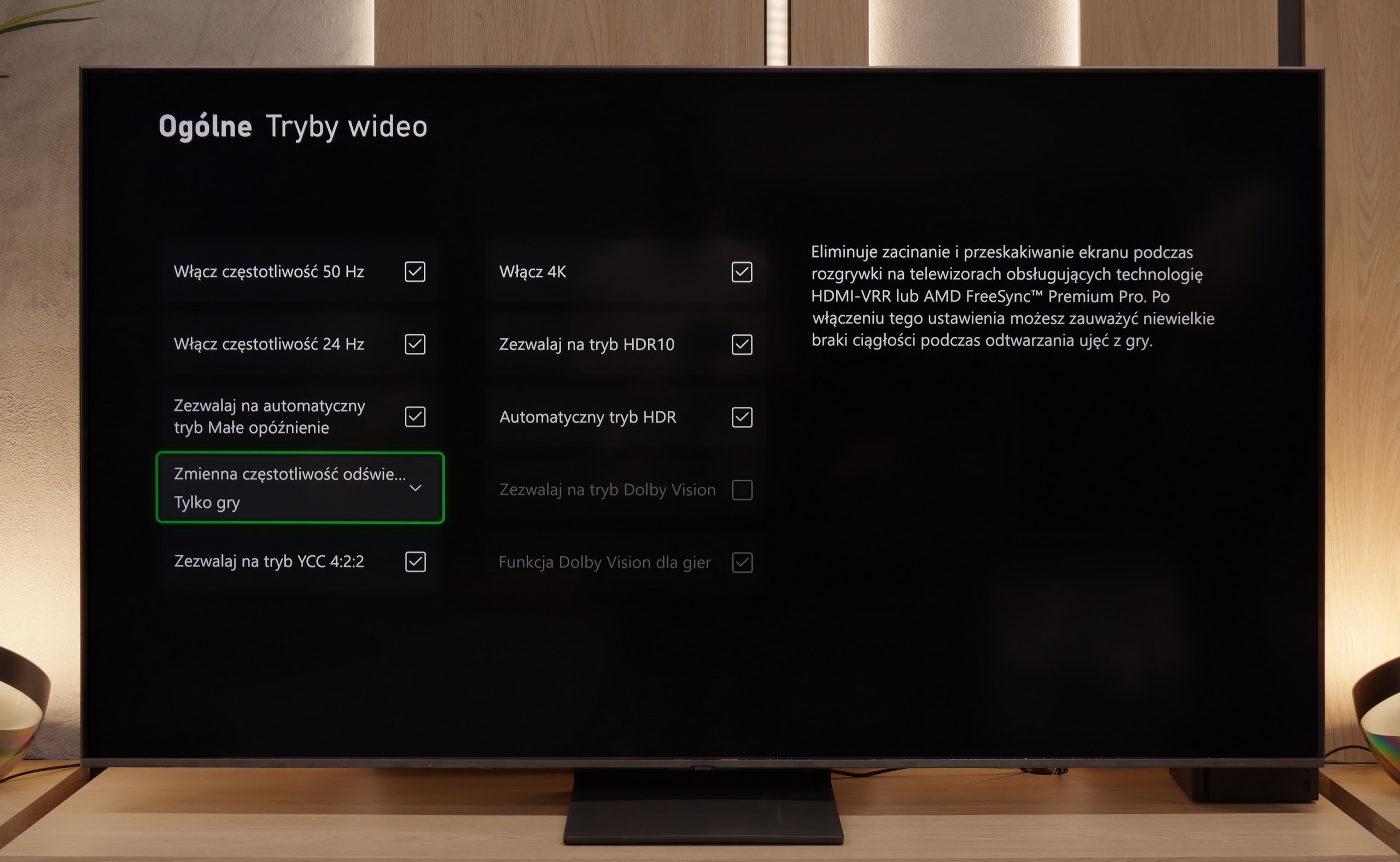



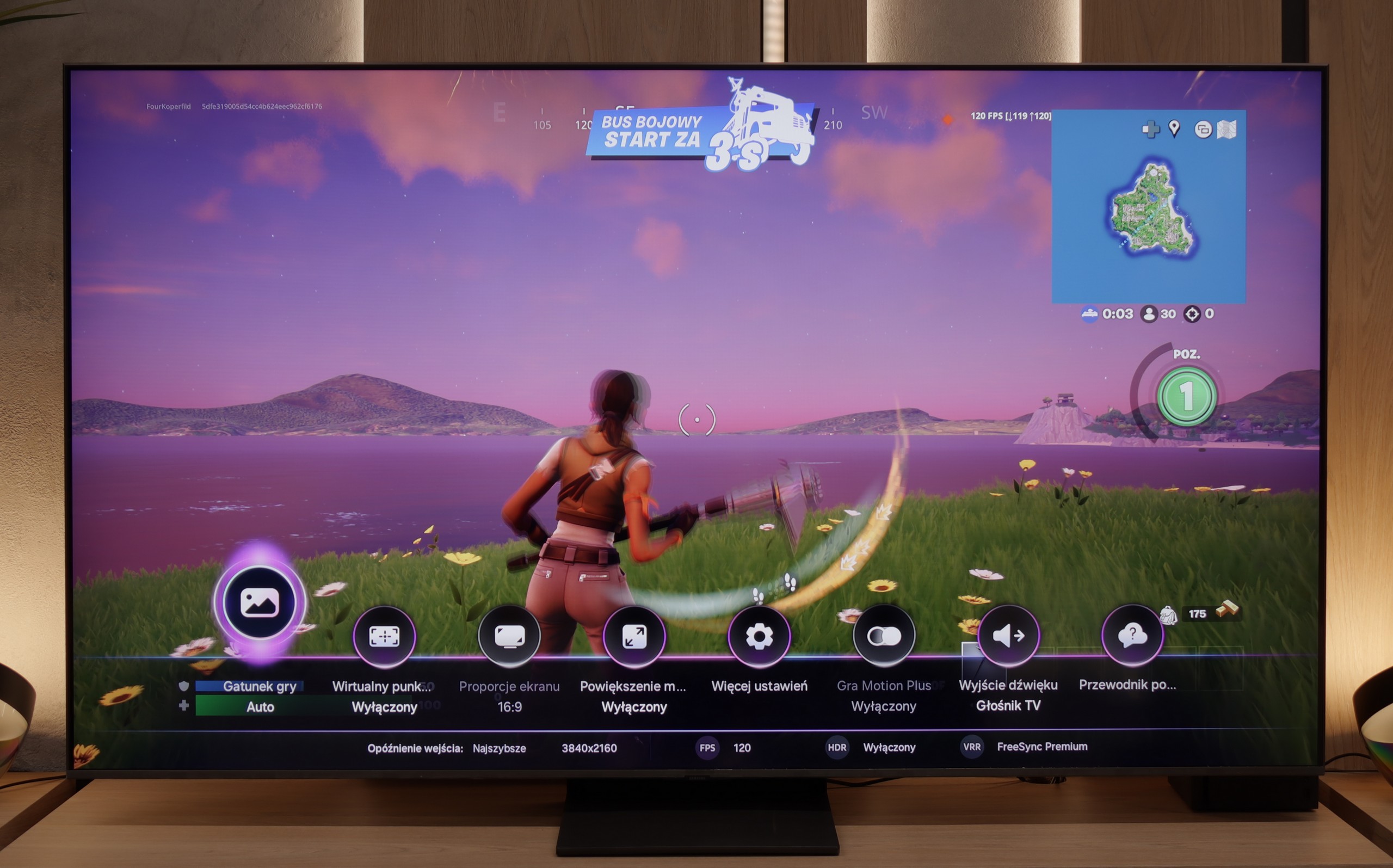

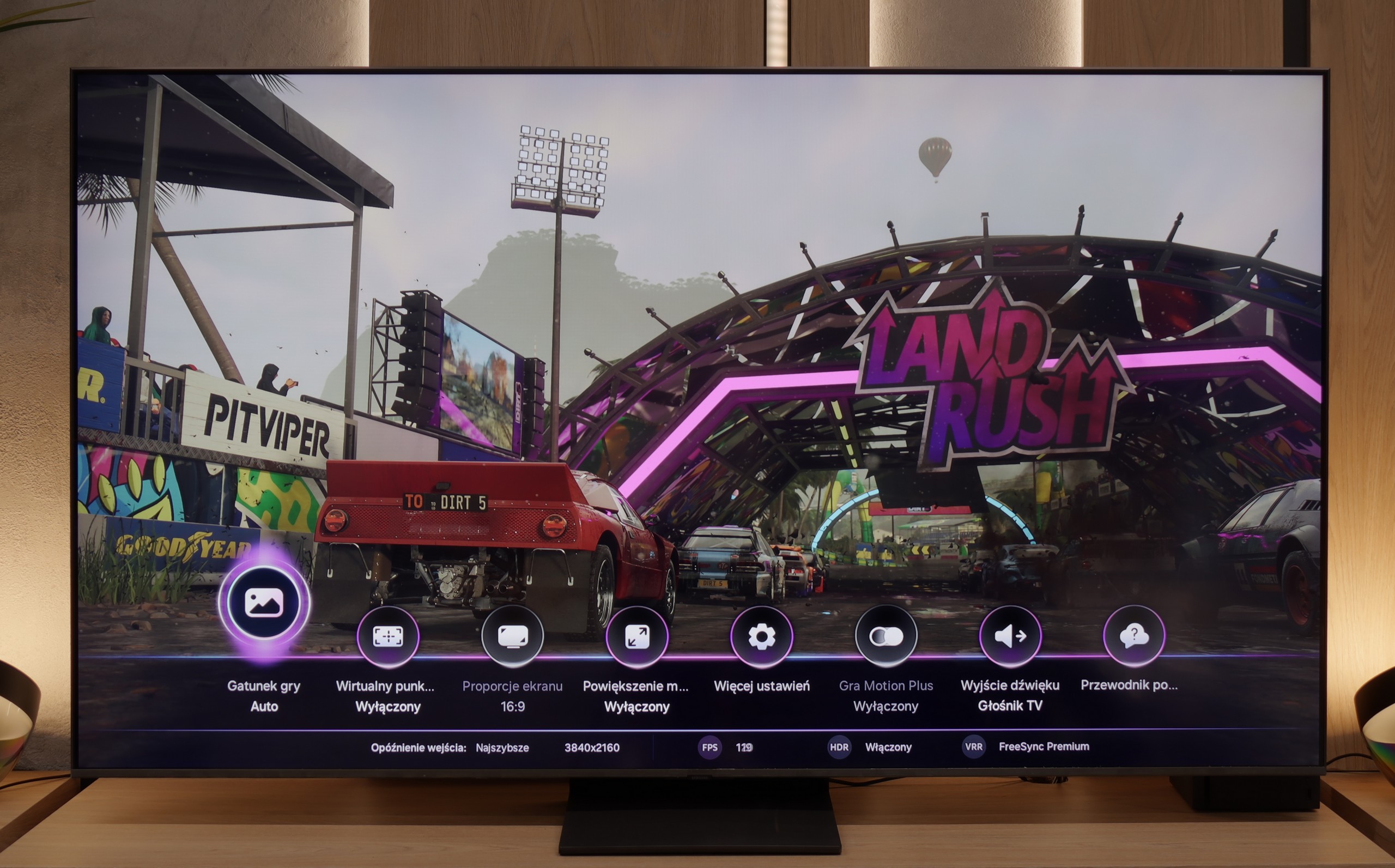
TCL MQLED85/C765 has achieved an impressive rating in the gaming features category, making it an excellent choice for gaming enthusiasts. The television supports all the latest technologies that significantly enhance the gaming experience. Among the key gaming features is ALLM (Auto Low Latency Mode), allowing the TV to automatically switch to low latency mode, minimising response time and ensuring smooth gameplay. VRR (Variable Refresh Rate) supported from 48 to 144 Hz eliminates stuttering and screen tearing in dynamic game scenes. Additionally, the TV supports the Dolby Vision Game Mode, which provides better image quality in games with exceptional depth of colour and contrast. TCL MQLED85/C765 also features a decent but not the best implementation of HGiG (HDR Gaming Interest Group), optimising the display of HDR games, however, in the case of TCL, it causes bright details to wash out, resulting in some elements merging into a white blob - more on this can be read in the colour reproduction section. It supports various resolutions such as 1080p@120Hz, 1440p@120Hz, and 4K@120Hz, allowing gamers to enjoy higher image quality and better fluidity. The Game Bar feature allows for easy switching between game settings and quick control of parameters, which significantly simplifies adjusting the TV to individual needs. With support for G-Sync and FreeSync technologies, users of NVIDIA and AMD graphics cards will be pleased with the refresh rate synchronisation capabilities, eliminating tearing and stuttering issues, ensuring smoother and more immersive gameplay.
MQLED85/C765 is a television that combines advanced technologies and excellent support for gamers, making it the ideal choice for those looking to maximise their gaming experiences.
Samsung QN80F is a TV that delivers on almost every front when it comes to gaming. We have a 144 Hz panel, four fully-fledged HDMI 2.1 ports, support for gamers in the form of variable refresh rate (VRR), auto low latency mode (ALLM), and even one of the best-designed game bars on the market. The cherry on top is the motion smoother, which – as the only one in the world – works in games without significantly increasing input lag. Sounds like an almost perfect TV for gamers? And indeed, it’s almost that.
As usual, Samsung does not support Dolby Vision in gaming, but that’s no surprise anymore. However, what is much more surprising is that... the HGIG feature has disappeared – which is a system that allows a console (e.g. PlayStation 5 or Xbox Series X) to precisely match HDR tone mapping to the capabilities of the TV. In the latest firmware update for the 2025 models, this option simply vanished. It looks more like a bug than a deliberate move, but it must be honestly noted that as of the writing of this review, the HGIG feature is simply absent.
And it’s this one missing feature that turns the QN80F from an almost perfect gaming TV into a “nearly” perfect device. It’s a pity – because everything else indicated that Samsung could once again set the bar very high in this generation.
Input lag
9.8/10
9.8/10
SDR
HDR
Dolby Vision
Latency in the TCL MQLED85 television reaches impressively low levels under any conditions. Even the most demanding gamers will surely appreciate the minimal input lag of just 8 ms at 4K 120 Hz settings with HDR. Moreover, the latency remains at the same level even when Dolby Vision HDR is enabled, which is not the case with many competing models.
The QN80F doesn't disappoint when it comes to response time. The input lag for 120 Hz content drops below 10 ms, which can be considered an almost perfect result – it's hard to expect more in this class of televisions. Gaming is smooth, responsive, and without delays that could annoy even the most sensitive players. For 60 Hz material, the lag is higher, around 19 ms, but this is a completely natural phenomenon and still falls within comfortable limits.
Compatibility with PC
8.6/10
8.8/10

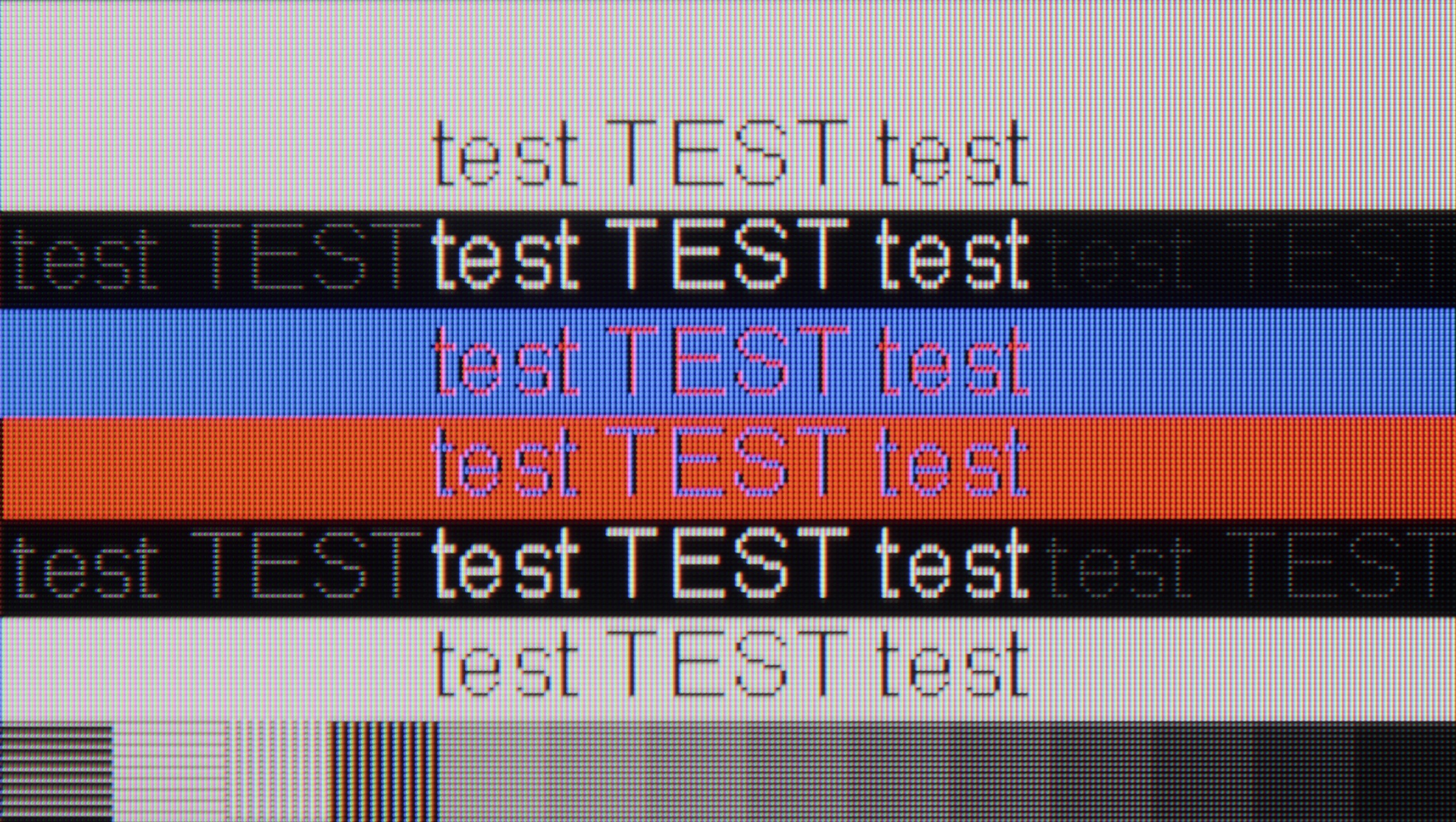
TCL MQLED85 works well as a computer monitor. Thanks to its support for chroma 4:4:4, the text on the screen is sharp and readable, which is essential for people working with text documents or spreadsheets. One of the biggest advantages of this model is its exceptionally low input lag in "PC" mode, which is just 8 ms. This is a reference-level result that ensures smoothness and responsiveness, crucial for both gamers and those involved in video editing. However, it's worth noting that there is a slight issue related to font display on dark backgrounds. Upon zooming in on the tested font picture, it can be seen that horizontal lines are darker compared to vertical ones. This means that the sub-pixels in the TV may not fully illuminate in such cases, which can affect the quality of displayed text. Nonetheless, the overall performance of TCL MQLED85 as a computer monitor is very good and will certainly meet the expectations of many users.
Playing on the QN80F with a computer connected is pure delight. The television works seamlessly with NVIDIA graphics cards (thanks to G-Sync support) and AMD (thanks to FreeSync Premium), and the 144 Hz refresh rate only enhances comfort during fast-paced gaming. Everything works right away, without unnecessary fiddling with settings – just as it should.
When it comes to work, it's very good as well. The readability of fonts is high, and texts look sharp and clear. With very thin horizontal lines, you might notice slight imperfections or shadows, but honestly – you have to take a good look. Unless, like us, you sometimes like to examine the screen with a magnifying glass… then you might spot something 😉.
Viewing angles
3.2/10
3.1/10
The viewing angles on the TCL MQLED85 television are not its strong suit. The use of a VA panel causes the image to lose a significant amount of brightness when viewed at an angle. Changing the viewer's position, especially in a larger group setting, can make colours appear less saturated, and contrast may be less distinct. For this reason, it's recommended to sit directly in front of the screen to fully enjoy the picture quality. Although the television offers excellent colour reproduction from a direct view, the loss of brightness and detail at an angle can be problematic for those who plan to use the television in a larger room or from various locations.
QN80F, like most TVs with a VA panel, isn't impressive in terms of viewing angles. Just tilt a bit to the side, and you'll notice a significant drop in brightness and lost colour saturation. The image loses its "depth" and "vividness", and darker scenes may appear slightly washed out. However, this is a typical characteristic of VA panels, which offer significantly better native contrast compared to IPS panels in return. In short: you win some, you lose some. If you're sitting directly in front of the screen – there won't be any issues. But when watching together in a larger group, it's worth keeping this in mind.
TV efficiency during daytime
6.3/10
6.6/10

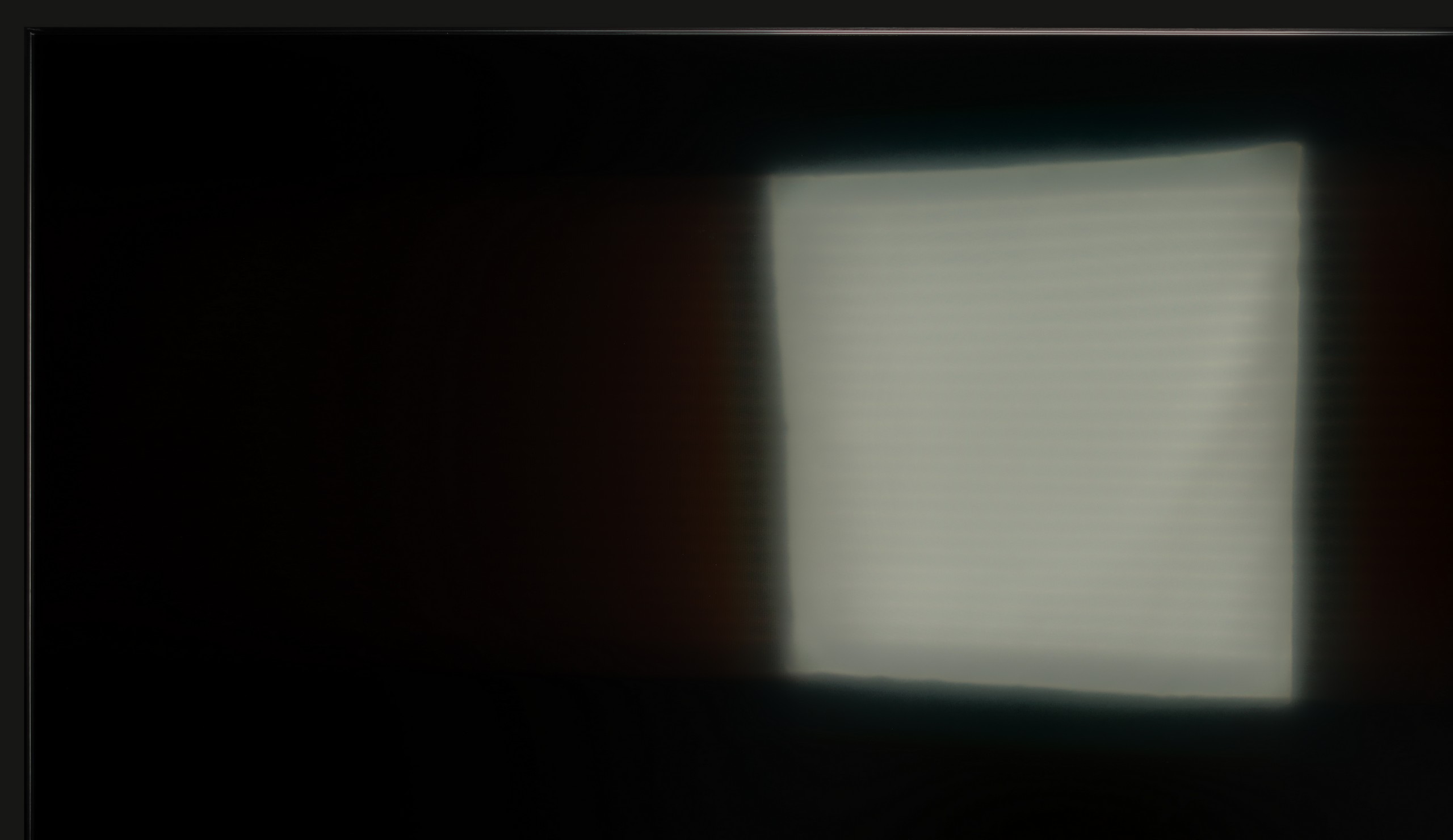

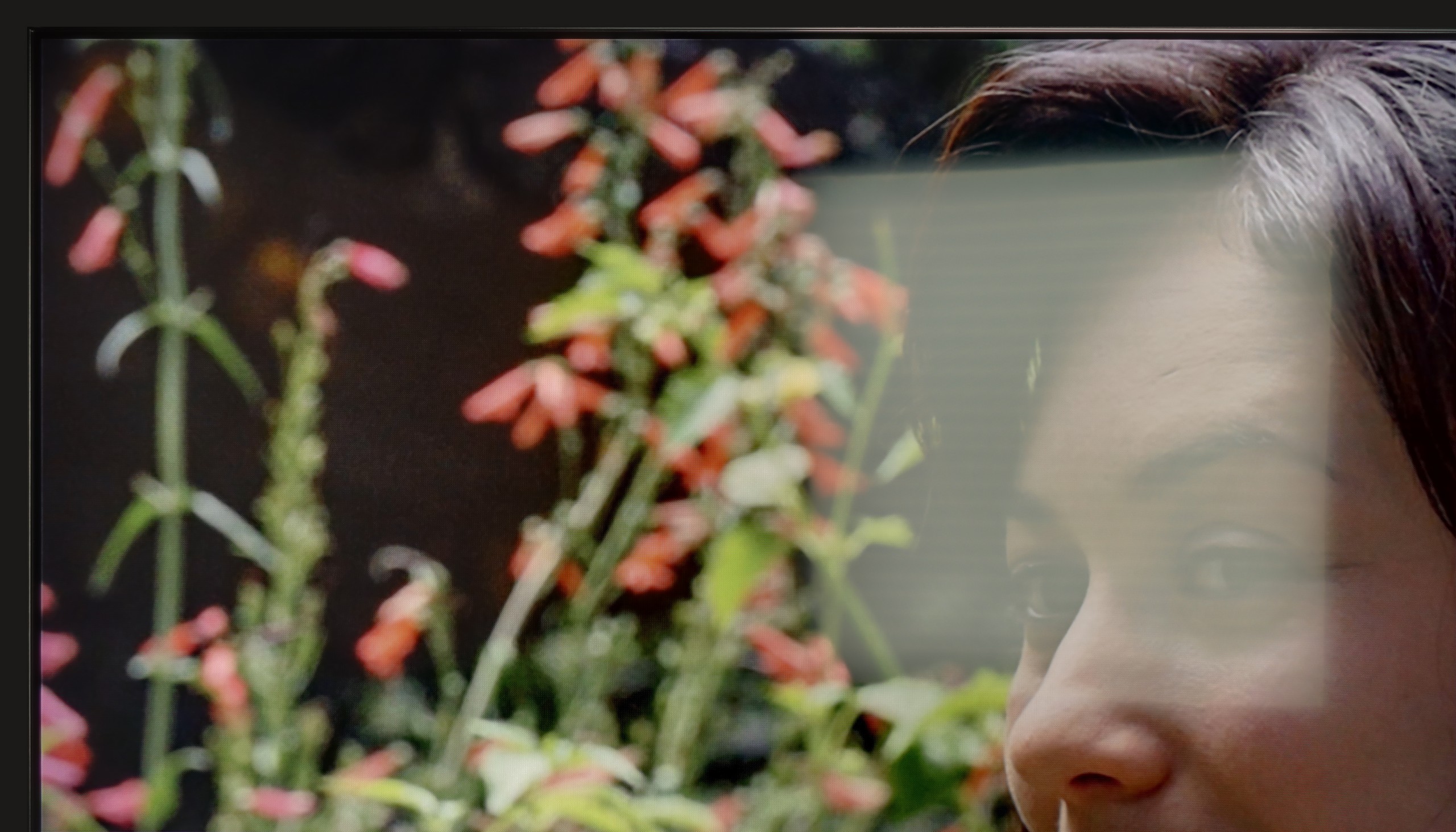
Matrix brightness
Average luminance SDR
SAMSUNG QN80F: 543 cd/m2
TCL MQLED85 / C765: 618 cd/m2
MQLED85 performs reasonably well in daylight conditions, and it's worth noting the satin finish of the panel. While it doesn't excel at reducing reflections, it offers decent performance in various lighting conditions. An average brightness level above 600 nits is an impressive result, allowing for comfortable viewing even in well-lit rooms. As a result, the television performs well both during the day and during evening movie screenings, providing satisfactory picture quality.
QN80F is really a bright television. The average brightness in SDR material is around 550 nits, regardless of the scene, which practically means that you can comfortably watch content even in a well-lit room – and there’s no need to close the blinds every time we turn on a film. The new satin coating on the panel also deserves praise, as it handles glare much better compared to last year's QN80D. Reflections are less bothersome, and the screen maintains readability in various lighting conditions. It’s hard to nitpick here – the QN80F performs simply brilliantly during the day.
Details about the matrix
Subpixel Structure:

Panel uniformity:

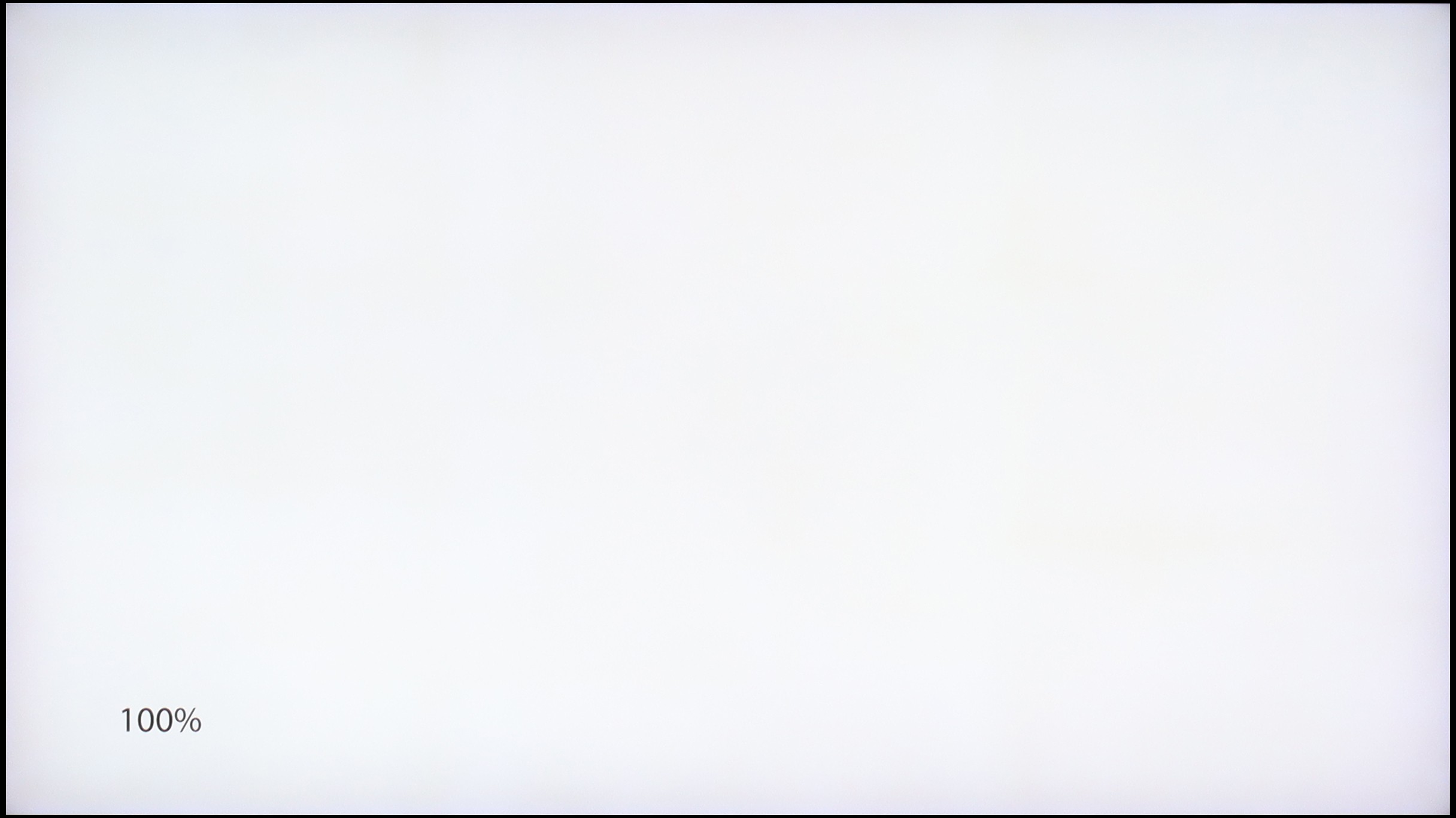
TCL MQLED85 / C765
SAMSUNG QN80F
TV features
7.1/10
7.5/10
- HDMI inputs2 x HDMI 2.0, 2 x HDMI 2.1 48Gbps0 x HDMI 2.0, 4 x HDMI 2.1 48Gbps
- Other inputsRCA (Chinch)
- OutputsToslink (Optical audio), eARC (HDMI), ARC (HDMI)Toslink (Optical audio), eARC (HDMI), ARC (HDMI)
- Network InterfacesWi-Fi 2.4GHz, Wi-Fi 5GHz, Ethernet (LAN) 100MbpsWi-Fi 2.4GHz, Wi-Fi 5GHz, Ethernet (LAN) 100Mbps
- TV receptionDVB-T, DVB-T2, DVB-S, DVB-S2, DVB-CDVB-T, DVB-T2, DVB-S, DVB-S2, DVB-C
Classic features:
- Recording to USB (terrestrial TV)
- Recording programming
- Picture in Picture (PiP)
- RF remote control (no need to aim at the screen)
- Backlit remote control
- Teletext
- Audio only mode
- Possibility to connect Bluetooth headphones to the TV
- Possibility to simultaneously use Bluetooth headphones and the TV speaker
Smart features:
- AirPlay
- Screen mirroring (Windows Miracast)
- Wyszukiwanie głosowe
- Voice search in native language
- Ability to connect a keyboard and mouse


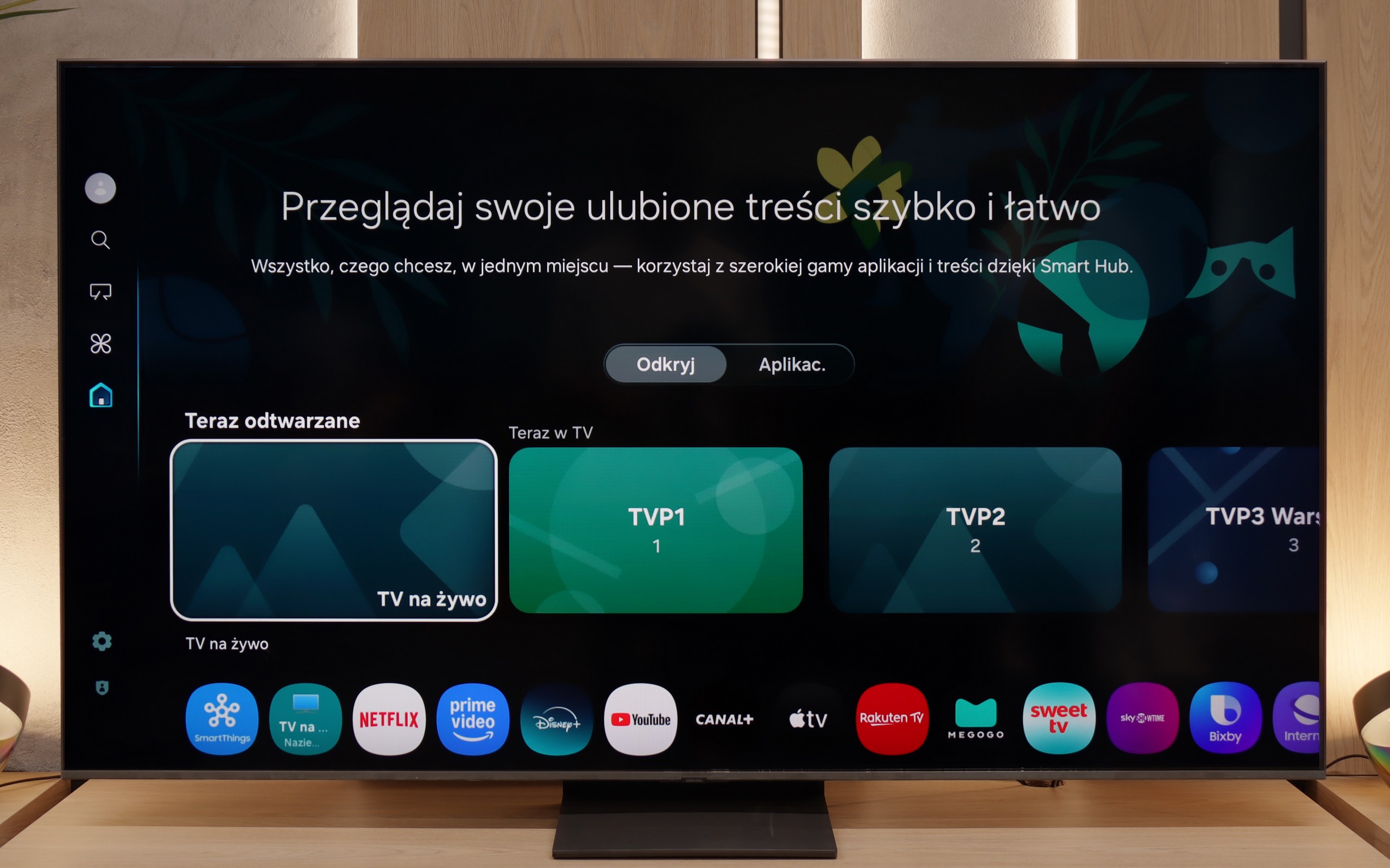
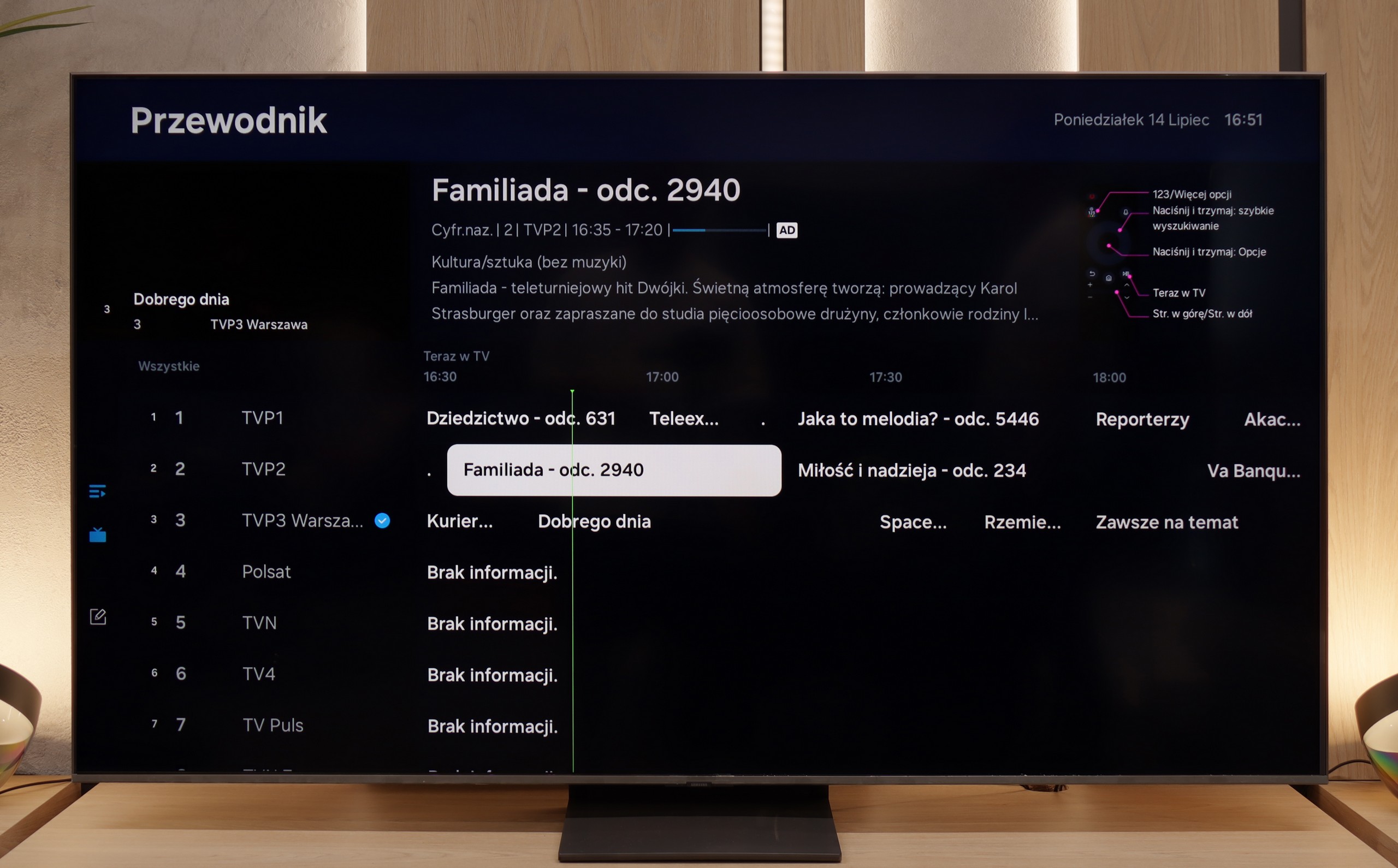
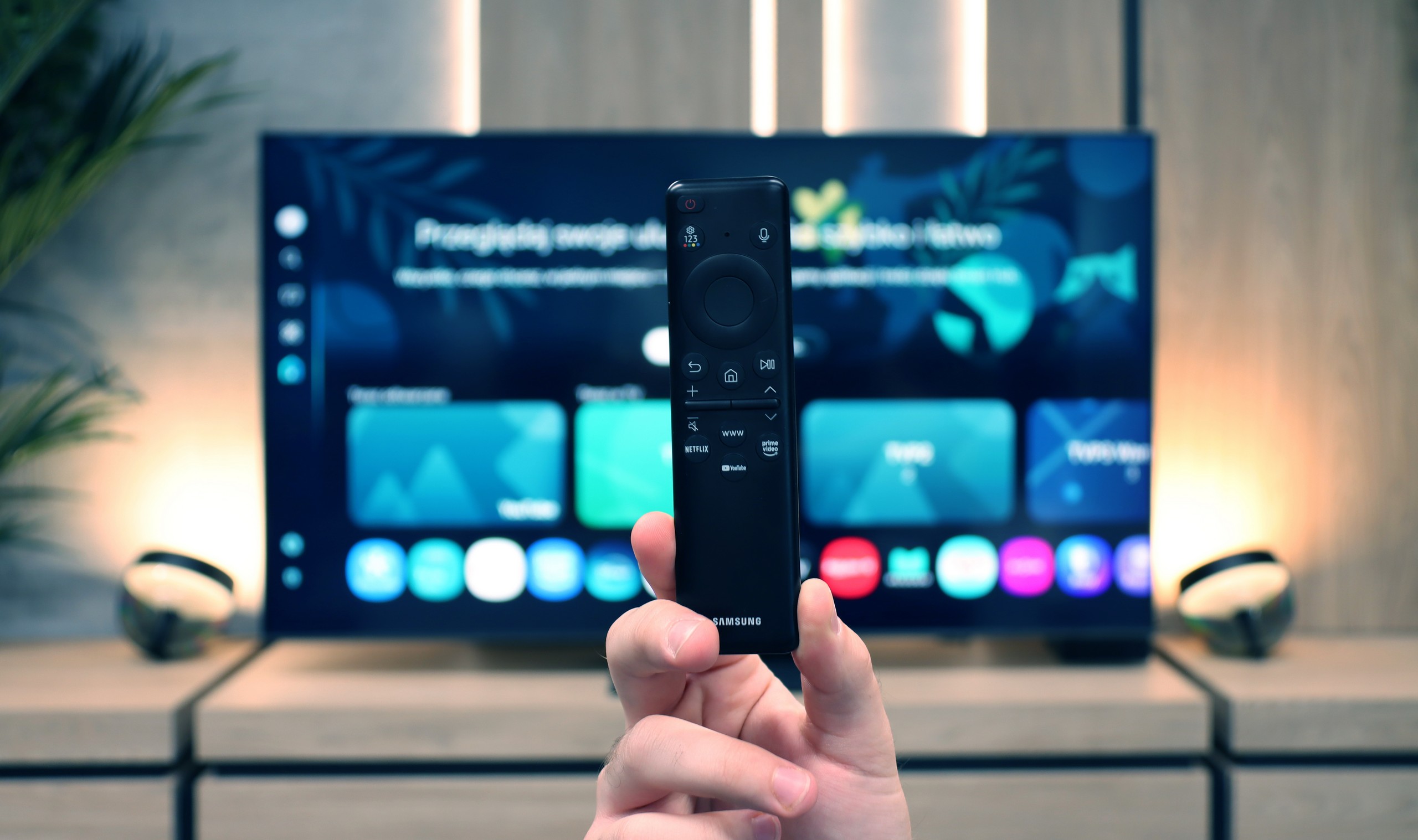
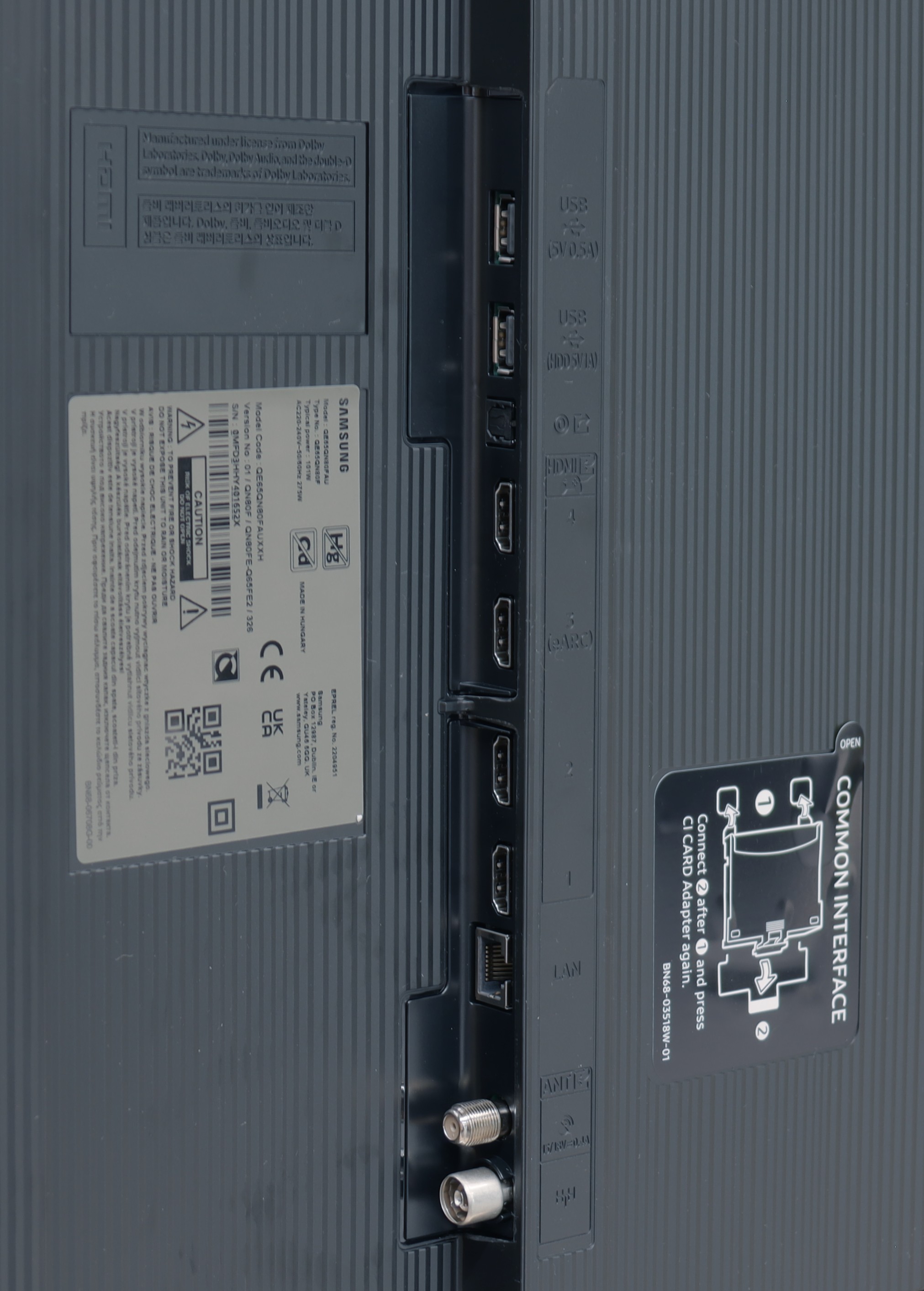
TCL MQLED85 TV offers many features that enhance user comfort, with the central point of its functionality being the Google TV system. This modern interface allows for easy content browsing, as well as access to apps available in the Google Play store. Users can take advantage of voice search in Polish, which greatly simplifies navigation and allows for quick finding of interesting shows, movies, or apps. It's also worth noting that Google TV is currently the only system on the market that does not restrict Polish users' access to apps, offering the greatest availability among all available platforms. However, in the context of traditional TV watching, this television has its limitations. It does not offer a recording function, which may be a significant downside for those who would like to save their favorite programs. Additionally, the lack of Picture-in-Picture (PIP) option limits the ability to simultaneously track multiple video sources. On the other hand, the TV features a "MultiVision" function, which allows for screen splitting between the TV and a mobile device. This way, users can use apps on their phone while still watching a TV program. This solution will certainly appeal to those who enjoy multitasking and want to watch TV while also engaging with social media or browsing the internet on their smartphone. Despite some limitations, the TCL MQLED85 TV presents itself as a solid option for users who value modernity and functionality.
SmartTV QN80F: Tizen
When it comes to smart features, the QN80F has nothing to be ashamed of. On the contrary – Tizen is one of the richest operating systems in terms of functionality. We have voice search, AirPlay support, Miracast and all the major streaming platforms at our fingertips. But Samsung's real advantage reveals itself in the smart home – SmartThings. Not only can you sync light bulbs and vacuum robots, but you can also integrate devices from other manufacturers, thanks to support for the Matter standard. And suddenly it turns out that the QN80F can serve as a home command centre. There is just one "but" – Tizen is a closed system, so we might not find a few lesser-known apps. However, in practice, it still has everything that 99% of users need.
Classic TV features:
When it comes to classic features, it’s just as good – well, almost. The QN80F supports Picture-in-Picture, a rare but still useful PiP feature. We'll easily find EPG, the good old teletext (yes, it works!) and the ability to connect external devices via Bluetooth – whether it's headphones or a soundbar. Unfortunately, it lacks the option to record to USB from the built-in tuners. This is a small annoyance, especially since competitors in a similar price range are increasingly offering this feature. It may not be a must-have function, but since everything else works so well, it’s a shame it's missing that finishing touch.
Playing files from USB
8.9/10
8.4/10
Supported photo formats:
Maximum photo resolution:

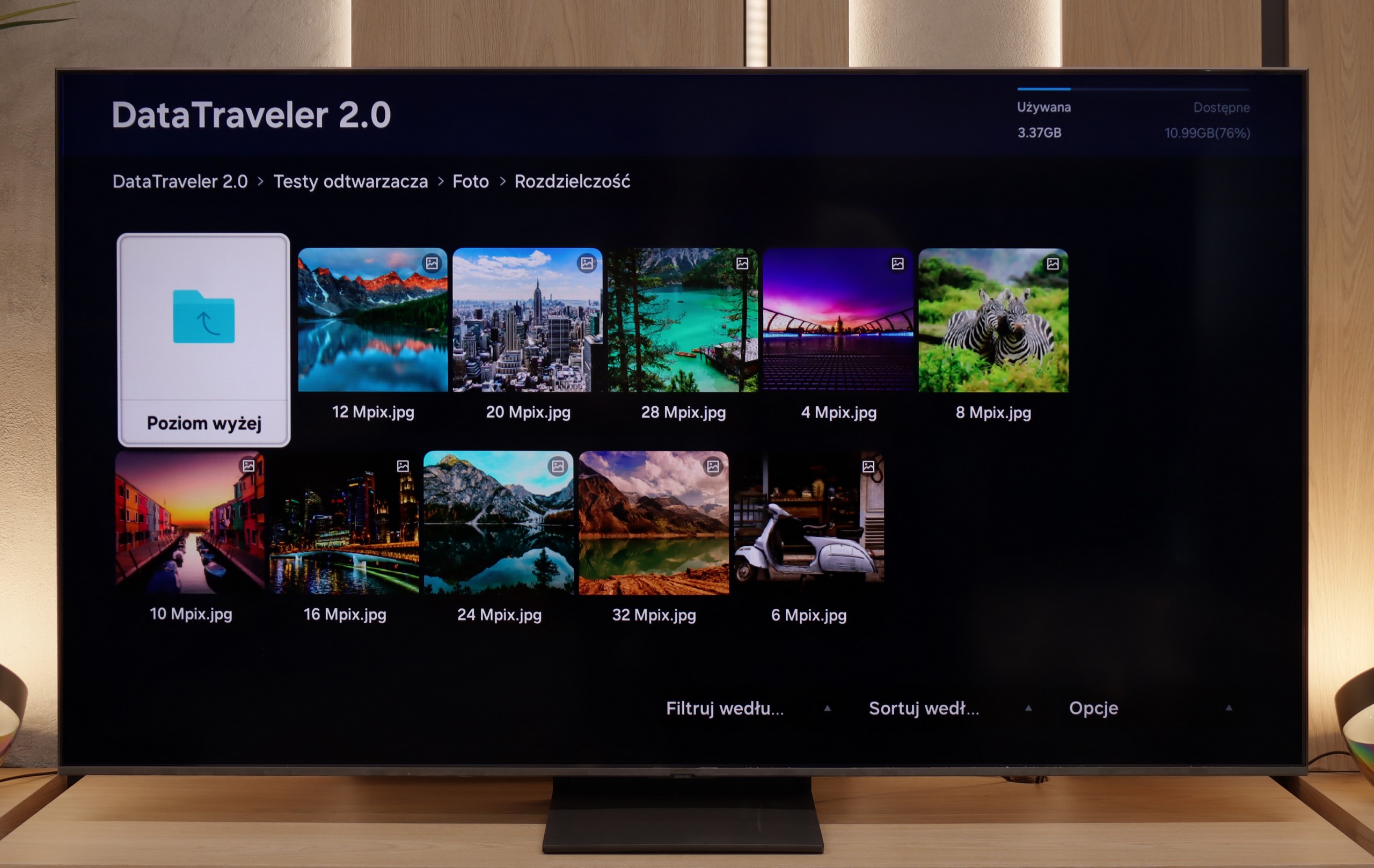
Thanks to the built-in player, the television is able to play most file formats found on external storage, making it a versatile tool for consuming multimedia. However, there may be some limitations in supporting certain formats, which can be bothersome for more demanding users. Fortunately, the Google TV system allows for the installation of other media players from Google Play, which helps eliminate compatibility issues. This gives users the ability to choose applications that best meet their needs, significantly increasing the functionality of the television.
The built-in media player in the QN80F handles most popular video formats – from classic MP4 to more demanding containers. It may not be as versatile as VLC, but for home use, it’s more than sufficient. The situation is worse with photos – here, unfortunately, it’s quite limited. Support mainly includes the JPG format, but hey, at least that’s the most important one 👌. During our tests, there was also a minor issue with subtitles. The QN80F only handled the simple text format .txt – unfortunately, other, more advanced formats (like .srt or .sub) were not recognized.
Apps
9.6/10
8.7/10














































Sound
6.9/10
6.7/10
- Subjective sound quality:6.9/106.7/10
- Dolby Digital Plus 7.1:
- Dolby True HD 7.1:
- Dolby Atmos in Dolby Digital Plus (JOC):
- Dolby Atmos in Dolby True HD:
- DTS:X in DTS-HD MA:
- DTS-HD Master Audio:
The sound of the television TCL MQLED85 can be described as decent, making it sufficient for everyday watching of movies, TV shows, and gaming. The speakers branded with Onkyo offer surprisingly good audio quality, and the sound does not crackle or distort even at higher volume levels.
For a TV of this class, the QN80F sounds surprisingly good. It supports the Dolby Atmos format, which is worth noting as this is still not obvious in many models in this range. Unlike the thinner QN70F, here you can even feel a slight bass – all thanks to the thicker casing, which simply provides more space for the sound to "breathe". It's perfectly adequate for everyday viewing and series, and with the right settings, you could even consider listening to music without the need to connect external equipment. But – as is the case with Samsung, there is unfortunately a lack of support for the DTS:X format, so if we are using audio devices that support this format, we will first need to connect them to the amplifier and only then to the TV.


